
???
Setting Up Your
Workgroup Server 8550
Includes information about setting up and expanding your server system; also includes technical specifications

???
Setting Up Your
Workgroup Server 8550
Includes information about setting up and expanding your server system; also includes technical specifications
KApple Computer, Inc.
??1996 Apple Computer, Inc. All rights reserved.
Under the copyright laws, this manual may not be copied, in whole or in part, without the written consent of Apple. Your rights to the software are governed by the accompanying software license agreement.
The Apple logo is a trademark of Apple Computer, Inc., registered in the United States and other countries. Use of the ???keyboard??? Apple logo
Every effort has been made to ensure that the information in this manual is accurate. Apple is not responsible for printing or clerical errors.
Apple Computer, Inc. 1 Infinite Loop
Cupertino, CA
Apple, the Apple logo, AppleScript, AppleSearch, AppleShare, AppleTalk, EtherTalk, LaserWriter, LocalTalk, Macintosh, PlainTalk, QuickTime, and StyleWriter are trademarks of Apple Computer, Inc., registered in the United States and other countries.
AppleCD, AudioVision, Balloon Help, Disk First Aid, Finder, GeoPort, Mac, Power Macintosh, PowerTalk, and QuickDraw are trademarks of Apple Computer, Inc.
Adobe, Adobe Illustrator, Adobe PhotoShop, and PostScript are trademarks of Adobe Systems Incorporated, which may be registered in certain jurisdictions.
Helvetica and Times are registered trademarks of Linotype Company.
IBM is a registered trademark of International Business Machines Corporation.
Macintosh Basics was developed using VideoWorks Interactive. VideoWorks Interactive is a trademark of Macromedia, Inc. (formerly MacroMind, Inc.).
Microsoft is a registered trademark, and Windows is a trademark of Microsoft Corporation.
Motorola is a registered trademark of Motorola Corporation. NuBus is a trademark of Texas Instruments.
PowerPC is a trademark of International Business Machines Corporation, used under license therefrom.
QuarkXPress is a registered trademark of Quark, Inc.
Retrospect Remote is a trademark of Dantz Development Corporation.
Simultaneously published in the United States and Canada.
Mention of

Contents
Communications regulation information / viii
Laser information / ix
About This Guide / 1
About your Workgroup Server 8550 and
Power Macintosh software / 1
Who should read this guide / 2
What this guide contains / 2
How to use this guide / 2
Other reference material / 3
Where to find answers / 4
1Setting Up Your Server / 5
Your server at a glance / 6 Security issues / 8
Physically isolating the system / 8 Using a locking cable / 8
Installing internal devices / 9 Connecting a monitor / 9
Connecting the monitor???s power cord / 9 Connecting the monitor cable / 11
iii

Connecting the mouse and keyboard / 12 Connecting a keyboard with a
Connecting other external devices / 13
Plugging in the server / 14
Turning the server on / 15
Problems turning on your server? / 17
Turning the server off / 18
Using the Shut Down command / 18
2Connecting to the Network / 19
Connecting to an Ethernet network / 20 Connecting to
Connecting to a LocalTalk network / 24 Building a
Creating a
Setting up multihoming / 28
Use a router to connect each network segment / 28 Have users select the server in their own zone / 29
3Expanding Your Server and Connecting Other Equipment / 31
Opening the server safely / 32 Installing an expansion card / 34
Power requirements / 34
Installing a PCI expansion card / 35 Upgrading the processor / 40
iv Contents

Expanding memory / 41
Connecting hard disks and other SCSI devices / 42
Setting the SCSI ID number / 43
Installing an additional hard disk in the internal disk drive bracket / 45
Installing a drive in the auxiliary bay / 54
Connecting an external SCSI drive / 60
Installing a device driver / 62
Do you need to initialize a hard disk? / 62
Connecting a printer / 63
Connecting an additional monitor / 64
Connecting a trackball or other input device / 64
Connecting a modem or GeoPort Telecom Adapter / 65 Connecting audio equipment / 65
About your server???s sound ports / 66
Connecting most audio equipment / 67
Connecting and positioning a microphone / 68
Connecting external stereo speakers / 69
Appendix A Safety, Maintenance, and Health Information / 71
Important server safety instructions / 71
Handling your computer equipment / 72
Handling the monitor / 73
Handling the keyboard / 74
Handling floppy disks / 74
Handling
Ejecting a disk / 76
If you can???t eject a floppy disk / 76
Power supply / 77
Contents v

Cleaning your equipment / 77
Cleaning the server case / 77
Cleaning the monitor / 77
Cleaning the mouse / 77
Locking and unlocking the mouse / 79
Musculoskeletal discomfort / 81
Eye fatigue / 82
Arranging your office / 83
Avoiding fatigue / 84
What about electromagnetic emissions? / 85
Appendix B Technical Information / 87
Expanding your Workgroup Server 8550 / 88
Specifications / 89
Main unit / 89
Processor / 89
Memory / 89
DRAM, VRAM, and cache configurations / 89
DRAM configurations / 90
VRAM configurations / 91
Cache configurations / 91
Adding DRAM / 91
Graphics modes / 92
Internal disk drives / 94
Clock/calendar / 94
Keyboard / 94
vi Contents

Mouse / 94
Interfaces / 94
Audio system / 96
Typical specifications / 96
AC line input / 98
AC line output / 98
DC power / 98
Power requirements for devices you can connect / 98 Apple Desktop Bus (ADB) / 98
Audio and telecommunications devices / 99 Expansion cards and devices / 99
Assigning SCSI ID numbers / 100
Size and Weight / 101
Environment / 101
Operating temperature / 101
Storage temperature / 101
Relative humidity / 101
Altitude / 101
Specifications for the 600i
Audio capacity / 102
Modes supported / 103
Data streaming and transfer rates / 103
Power consumption (typical) / 103
Laser / 103
Index / 105
Contents vii

Communications regulation information
FCC statement
DOC statement
This equipment has been tested and found to comply with the limits for a Class A digital device pursuant to Part 15 of the Federal Communications Commission (FCC) rules. These limits are designed to provide reasonable protection against such interference when the equipment is operated in a commercial environment. This equipment generates, uses, and can radiate
DOC Class A Compliance
IMPORTANT Changes or modifications to this product are not authorized by Apple Computer, Inc., and could void the FCC certification and negate your authority to operate the product. This product was tested for FCC compliance under conditions that included the use of shielded cables and connectors between system components.
It is important that you use shielded cables and connectors to reduce the possibility of causing interference to radios, television sets, and other electronic devices. For Apple peripheral devices, you can obtain the proper shielded cables through an
Observation des
This digital apparatus does not exceed the Class A limits for radio noise emissions from digital apparatus set out in the radio interference regulations of the Canadian Department of Communications.
bruits radio??lectriques d??passant les limites applicables aux appareils num??riques de la Classe A prescrites dans les r??glements sur le brouillage radio??lectrique ??dict??s par le Minist??re des Communications du Canada.
VCCI statement
CE statement
This equipment has been designed, tested, and found compliant with the Class A limits for Information Technology Equipment of EN55022. These limits are designed to provide reasonable protection against radio interference when the equipment is operated in a commercial environment.
This equipment generates, uses, and may radiate
Operation of this equipment is a residential area may cause radio interference, in which case the user will be required to correct the interference at his own expense.
viii Communications regulation information

Laser information
WARNING Making adjustments or performing procedures other than those specified in your equipment???s manual may result in hazardous radiation exposure.
WARNING Do not attempt to disassemble the cabinet containing the laser. The laser beam used in this product is harmful to the eyes. The use of optical instruments, such as magnifying lenses, with this product increases the potential hazard to your eyes. For your safety, have this equipment serviced only by an
If you have an internal Apple

About This Guide
This guide tells you how to set up your Workgroup Server 8550 and connect it to a network. It also provides technical specifications for your server and information about adding internal and external devices to your server. This setup guide is a companion to the Workgroup Server Administrator???s Guide, which tells you how to configure the system software for use with your Workgroup Server, use application software programs, use your server???s built- in
About your Workgroup Server 8550 and Power Macintosh software
Your Workgroup Server 8550 is powered by the PowerPC??? microprocessor (or ???chip???). This microprocessor was designed by Apple Computer, Inc., Motorola, Inc., and IBM Corporation. The PowerPC microprocessor uses Reduced Instruction Set Computer (RISC) technology to deliver very high performance at the lowest possible cost. The PowerPC RISC microprocessor represents the state of the art in microprocessor design.
Your Workgroup Server 8550 will run almost all of your existing Macintosh software, but for best performance and greatest speed, look for software programs designed especially for Power Macintosh computers. You???ll find Power Macintosh programs at any software store that carries products
for Macintosh.
1

Who should read this guide
This guide is intended for the person who sets up the server and connects it to an existing network. You need to know some details of your existing network in order to choose the appropriate procedures for connecting the server to your network.
What this guide contains
Here???s a brief summary of what you???ll find in this guide:
mChapter 1, ???Setting Up Your Server,??? provides a graphic overview of the Workgroup Server 8550, and explains how to connect the monitor, keyboard, and mouse, and how to start up your server for the first time.
mChapter 2, ???Connecting to the Network,??? describes how to connect the server to an Ethernet or LocalTalk network, and provides information about setting up a
mChapter 3, ???Expanding Your Server and Connecting Other Equipment,??? describes how to install expansion cards and additional internal drives in your server, and connect additional external devices to the server.
mAppendix A, ???Safety, Maintenance, and Health Information,??? suggests how you can create a healthful and safe server environment and keep your server equipment in good working order.
mAppendix B, ???Technical Information,??? contains technical specifications for your server.
How to use this guide
Familiarize yourself with your server??? basic components. See the section ???Your Server at a Glance??? in Chapter 1.
Consider security issues and placement of your server. Read the section ???Security Issues??? in Chapter 1 for important information about protecting your server from unauthorized access.
If you want to add an expansion card or internal drive to the server: Install the card or internal device according to the instructions in Chapter 3, ???Expanding Your Server and Connecting Other Equipment.??? Then return to Chapter 1 to connect the monitor and keyboard.
2 About This Guide

If you want to connect external peripheral devices to your server: After you connect the monitor and keyboard to the server, as described in Chapter 1, turn to the appropriate instructions in Chapter 3, then return to Chapter 1.
Connect to the network to complete the setup process. See Chapter 2, ???Connecting to the Network,??? for details.
Other reference material
In addition to this guide, you may need to consult the following sources of information.
mAfter setting up your server???s hardware, see the Workgroup Server Administrator???s Guide for details on configuring and using the features of the Mac OS and Macintosh application programs. The Administrator???s Guide also contains information about using your server???s DAT and
mFor important
mFor information about server application programs included with your Workgroup Server 8550, such as Apple RAID Software and Retrospect Remote, refer to the documentation for those programs included in the server accessory kit.
mThere are a number of network services, such as AppleShare, AppleSearch, and Apple Remote Access, that can be installed on your Workgroup Server 8550. Refer to the documentation included with those services for installation and operation information.
mIf you purchased an Apple Internet Server, see the setup booklet included in the Apple Internet Server Solution for the World Wide Web package.
mIf you need a better understanding of how to configure your network, the following books from Apple Computer, published by
Understanding Computer Networks gives an overview of networking basics.
Planning and Managing AppleTalk Networks provides
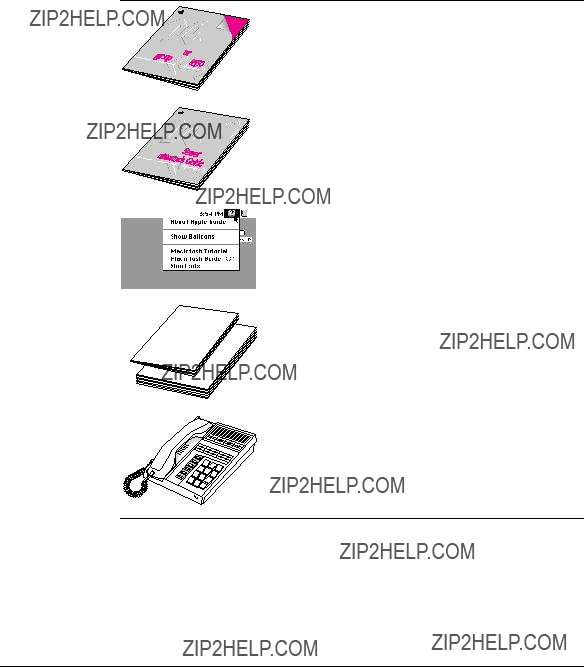
Where to find answers
When you have questions about using your server, there are several places you can look for answers.
In this book
Use this book to help you set up and expand your server system, and to connect it to a network. Also use this book to check your server???s technical specifications.
Workgroup Server
Administrator???s Guide
In the Workgroup Server Administrator???s Guide
Use this book to configure the operating system for your server, to learn about the Mac OS, for troubleshooting information if you experience problems with your server, and to learn about your server???s DAT and
In the Guide menu
The Guide menu (marked with the h icon) is your main source of information about the Mac OS. To learn how to get different kinds of help from the Guide menu, see Appendix A in the
Workgroup Server Administrator???s Guide.
In other manuals
For answers to questions about other equipment or about application programs you have purchased, see the manuals that came with the equipment or programs.
From Apple???s customer support hotline
If you can???t find an answer in any of the materials provided, call the customer support hotline. (The phone number for the hotline is in the service and support information that came with your server.)
4 About This Guide

Setting up your server involves connecting a monitor, mouse, and keyboard, expanding your system to suit your needs, and connecting to the network.
First, acquaint yourself with your server???s features, as shown in the next section, ???Your Server at a Glance.??? Also, be sure to read the section ???Security Issues??? for important information about protecting your server from unauthorized access. Then, if you want to install an expansion card or install other internal devices, see the appropriate sections in Chapter 3 before returning to the setup procedures in this chapter. Once you???ve connected the monitor, mouse, and keyboard, you may need to refer to Chapter 3 again if you???re connecting external devices.
You complete the setup process by connecting your server to the network, as described in Chapter 2. Once your server is connected to the network, see the
Workgroup Server Administrator???s Guide for instructions on configuring your server???s system software.
5

Your server at a glance
The following figure shows the basic components of your Workgroup Server 8550 assembled and connected to a network.
Floppy disk drive
Auxiliary bay for optional DAT or hard disk drive
Internal disk drive bracket
Bay for secondary drive
Startup drive
Monitor
Monitor power light
Power key
Mouse
The ports on the back of the Workgroup Server 8550 and the icons that identify them are shown in the following figure. During setup, you???ll connect hardware to some of these ports.
6 Chapter 1 / Setting Up Your Server

gSCSI port
G Ethernet port (AAUI)
G Ethernet port
WModem port (GeoPort)
[Printer port (GeoPort)
???Sound input port
-Sound output port
??? Power socket
Monitor power socket
??? Monitor port
VApple Desktop Bus (ADB) port
Access covers for expansion slots (3)
F Security lock ports
Your server???s ports and connectors
Ethernet port (AAUI) Ethernet port
GConnects your server to an Ethernet network using an adapter.
GConnects your server to an Ethernet network using a
WConnects your server to an external modem, LocalTalk network, or GeoPort Adapter.
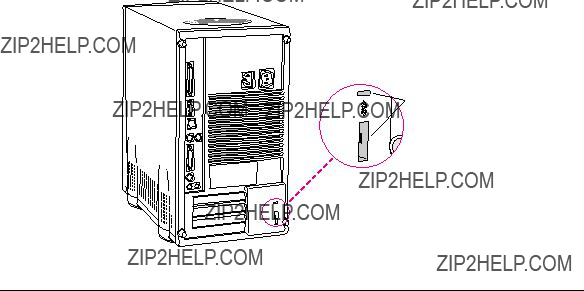
Security issues
The Workgroup Server 8550 lets you concentrate valuable or sensitive information on one system that can be physically isolated and more carefully monitored than would be possible if that information were stored on personal computers. Before you set up the server, you may want to consider two measures that you can take to secure the hardware components: physically isolating the system and using a locking cable to secure the system.
Physically isolating the system
It is important to note that even if software security features (such as password protection or locking screen savers) are in use on the server, it is still possible to disconnect peripheral devices from your server. There is no better way to protect hardware components than by physically isolating the server
Using a locking cable
As an alternative to isolating the system completely in an area of controlled access, you can purchase a locking cable and attach it to your server. The back panel has a
F Security
lock ports
8 Chapter 1 / Setting Up Your Server

By itself, a locking cable cannot prevent unauthorized use of the server, but it can prevent the server (and its peripheral devices if they are also secured by locking cables) from being removed.
Installing internal devices
If you purchased additional internal drives or expansion cards for your server, install them now (see Chapter 3 for instructions). If you don???t have internal devices to install, go on to the next section, ???Connecting a Monitor.???
Connecting a monitor
You can connect many types of monitors (often called displays) to your server, including most standard monitors. See Appendix B, ???Technical Information,??? for a complete list.
This section contains instructions for connecting most types of monitor. To connect a monitor from a manufacturer other than Apple, refer also to the instructions that came with the monitor.
Connecting the monitor???s power cord
Monitors have two cords to connect: a power cord and a monitor cable. To connect the monitor power cord:
1Place the monitor where you will be using it.
Keep in mind these considerations:
m Allow a few inches for air circulation around the server and monitor.
m Make sure the top of the screen is slightly below eye level when you???re sitting at the keyboard.
m Position the monitor to minimize glare and reflections on the screen from overhead lights and windows.
m Consult ???Arranging Your Office??? in Appendix A for suggestions about locating your server equipment.
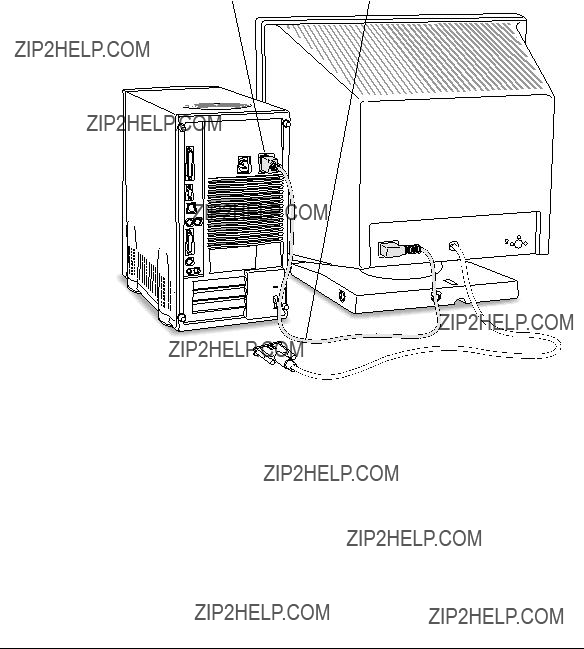
2Connect the monitor???s power cord to the monitor.
On some monitors, the cord is already attached.
3Plug in the monitor???s power cord to the server or grounded electrical outlet.
Some power cords are designed to plug into the back of your server. You
can also plug the power cord into a grounded electrical outlet (an adapter may be needed).
Note: If you have an Apple AudioVision monitor, plug the monitor???s power cord into the back of the server, not into an outlet.
Some monitors have to be connected to a grounded power outlet, not to the server???s power socket. Check the information that came with the monitor.
10 Chapter 1 / Setting Up Your Server

Connecting the monitor cable
After you plug in the monitor???s power cord, connect the monitor cable to the server???s monitor port.
To connect the monitor cable:
1Attach the monitor cable to the monitor.
On some monitors, the cable is already attached.
2Attach the monitor cable to the server???s monitor port.
The monitor port is marked with the icon ???. To connect the cable, firmly push it into the connector and then use the thumbscrews to secure the connection.
If you have an AudioVision monitor, see the information that came with the monitor to use its special features.
Connecting a monitor 11
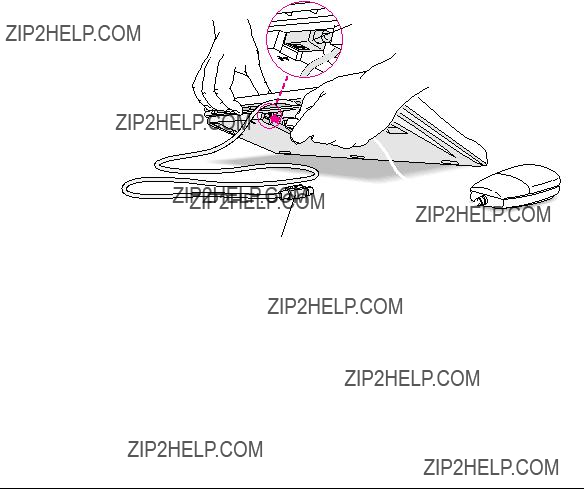
Connecting the mouse and keyboard
You have a choice of several keyboards for your server. The way you connect the mouse and keyboard depends on whether the keyboard has a separate cable or a
Connecting a keyboard with a
1Plug the mouse cable into the recessed port on the back of the keyboard.
The plug and the port are marked with the ??? icon symbol. The positions of the port and icon on your keyboard may be different from those pictured.
Note: A port marked with the ??? icon is called an Apple Desktop Bus (ADB) port.
Plug the mouse cable into the recessed port on the keyboard. The flat part of the plug should be pointing down, as shown here.
This cable plugs into the Apple Desktop Bus (ADB) port, marked with the ??? icon, on the back of the server.
2Plug the keyboard cable into the port on the back of the server marked with the ??? icon.
Some monitors have a ???port to which you can connect the keyboard or mouse. See the information that came with your monitor.
12 Chapter 1 / Setting Up Your Server

Connecting a keyboard with a separate cable
1 Plug the mouse cable into the port on either side of the keyboard.
ADB icon 


Most
The plug and the port are marked with the same icon (???). Align the icons before you insert the plug. The positions of the port and icon on your keyboard may be different from those pictured.
Note: The ??? port is called the Apple Desktop Bus (ADB) port.
2Plug the keyboard cable (both ends are the same) into the other port on the keyboard.
3Plug the keyboard cable into the port on the back of the server marked with the ???icon.
Some monitors have a ???port to which you can connect the keyboard or mouse. See the information that came with your monitor.
Connecting other external devices
If you want to connect other devices to your server, such as an external hard disk or a printer, follow the instructions in Chapter 3.

Plugging in the server
To plug in the server:
1Plug the socket end of the server???s power cord into the recessed power plug (marked with the symbol ???) on the back of the server.
2Plug the other end of the power cord into a
Choose a power outlet to which you have easy access.
WARNING This equipment is intended to be electrically grounded. Your server is equipped with a
Power cord socket
Power cord plug
IMPORTANT The only way to disconnect power completely is to unplug the power cord. Make sure at least one end of the power cord is within easy reach so that you can unplug the server when you need to.
14 Chapter 1 / Setting Up Your Server

Turning the server on
Before turning the server on, make sure it is in its upright position; the
Workgroup Server 8550 is not designed to run on its side.
To turn on the server for the first time, follow these steps.
1Turn on the monitor.
See the information that came with your monitor for the location of the power switch. On Apple monitors, the power switch has this icon: I.
Note: You only need to turn on the monitor once if its power cord is plugged into the server. From now on, the monitor will turn off automatically when you shut down the server, and it will turn on automatically when you start up the server. (If the monitor???s power cord is not plugged into the server, it must be turned on separately each time you turn on the server.)
2Turn on all external devices.
External devices may include hard disk drives,
3Turn on your server by pressing the Power key on the keyboard or pressing the Power button on the front panel of the server.
You???ll find the Power key at the top of the keyboard. You can recognize this key by the triangle outline.
Turning the server on 15

4Check to see what???s on your screen.
m If you see a system message on the desktop, as shown in the following figure, your Mac OS is already set up correctly. Click the OK button to dismiss the dialog box.
Startup disk icon
Mac OS desktop
Why the message about your network connection? The Workgroup Server is preset for a connection to an Ethernet network. When you start up your server for the first time (before connecting a network cable), you???ll see the dialog box shown above alerting you that the system temporarily switched the network connection from
See the Workgroup Server Administrator???s Guide for information on configuring your server???s software.
16 Chapter 1 / Setting Up Your Server

mIf you see a blinking question mark, you need to install system software on the server???s hard disk.
To install the Mac OS, see ???Installing System Software??? in Chapter 4, ???Managing Hard Disks,??? of the Workgroup Server Administrator???s Guide.
mIf you see anything else on your screen, or if you see nothing at all, see the next section, ???Problems Turning On Your Server????
Problems turning on your server?
If you don???t see anything on the screen, check these items to see if you can identify the problem:
mIs the server plugged into a power source? If it is plugged into a power strip, is the power strip turned on?
mIs the power light on the front panel on?
mAre the keyboard and mouse cables connected correctly? (Don???t disconnect the keyboard or mouse cables while your server is on. You could damage your equipment.)
mIs the monitor power cord plugged in?
mIs the monitor turned on? (Check the power light on the front of the monitor.)
mIs the monitor???s cable attached firmly to both the monitor and server?
mAre the brightness and contrast controls on the monitor adjusted correctly? (On Apple monitors, the brightness control is marked with the symbol ?? and the contrast control is marked with the symbol O.)
Turning the server on 17

Turning the server off
You need to turn off (shut down) the server to perform the tasks in Chapter 2, ???Connecting to the Network.???
IMPORTANT Be sure to turn off the server if you need to do any of the following:
mmove the server
mconnect other equipment to the server
munplug the server
You can turn off the server by pressing the Power button (located at the front of the server) or you can use the Shut Down command. Both procedures ready the startup disk for a fast restart the next time you turn on the server.
Using the Shut Down command
1 Choose Shut Down from the Special menu.
2Respond to the dialog boxes that may appear.
Applications that are running may display dialog boxes that prompt you to save open files or that ask you to enter a message that is to be displayed to users who are logged in to your server.
18 Chapter 1 / Setting Up Your Server

The Workgroup Server 8550 contains
You connect the server to a LocalTalk network through the printer port. The
The Workgroup Server 8550 is preconfigured to use the
Although your server is preconfigured to access one network segment at a time, with network server software (such as AppleShare 4.2.1) that supports the multihoming capabilities of Open Transport 1.1 (new communications software that is part of the Mac OS included with your server), you can set up your server to access multiple network segments at the same time. See the section ???Building a
19

Connecting to an Ethernet network
The
You can connect your server directly to an Ethernet network using a
mApple Ethernet Thin Coax Transceiver
mApple Ethernet AUI Adapter
See your
WARNING Do not connect cables to the back of the server when the power is on or you may damage your system.
You can connect an adapter and cable for an Ethernet network directly to the server without installing an expansion card. You can find the Ethernet ports on the back of your server by looking for the Ethernet icon:
Although you can connect cables to both of these Ethernet ports at the same time, you can use only one of these
The following sections provide basic instructions for connecting your server to an Ethernet network.
20 Chapter 2 / Connecting to the Network

Connecting to
Follow this procedure to connect the server to a network that implements Ethernet over
To connect the server to a
1Make sure that the server is turned off.
2Plug one end of the
3Plug the other end of the
The server is preset to use the network software connection for Ethernet. You can use network services as soon as you start up the server.

Connecting to thin coaxial Ethernet
Follow this procedure to connect the server to an Ethernet network that uses thin coaxial cable. The hardware connection requires an Apple (or Apple- compatible) thin coaxial transceiver and a thin coaxial cable.
To connect the server to a thin coaxial network:
1Make sure that the server is turned off.
2Attach one end of a thin coaxial cable to one of the posts on the thin coaxial transceiver.
3Attach the other end of the cable to the last thin coaxial transceiver on the network.
A thin coaxial network must be terminated at the endpoints to function. An Apple transceiver is
Note: You can connect the server anywhere along a network; however, to do so requires that you temporarily disconnect the network, which could disrupt existing network services.
4Plug the connector on the transceiver into the AAUI Ethernet port on the server.
Ethernet port (AAUI)
Ethernet thin coaxial transceiver
Thin coaxial cable
The server is preset to use the network software connection for Ethernet. You can use network services as soon as you start up the server.
22 Chapter 2 / Connecting to the Network

Connecting to other types of Ethernet
The Apple Ethernet AUI Adapter is a universal adapter that lets you connect the server to
To connect the server to an Ethernet transceiver for other types of Ethernet media:
1Make sure that the server is turned off.
2Connect the Ethernet transceiver to the network following the instructions in the documentation that came with the transceiver.
3Plug the transceiver cable from the Ethernet transceiver into the standard AUI port on the Apple Ethernet AUI Adapter.
Electrical outlet
Ethernet port (AAUI)
Apple Ethernet AUI Adapter
Ethernet transceiver 


 for other media
for other media 
4Plug the adapter???s power cord into a power outlet.
5Plug the connector on the Apple Ethernet AUI Adapter into the AAUI Ethernet port on the server.
The server is preset to use the network software connection for Ethernet. You can use network services as soon as you start up the server.

Connecting to a LocalTalk network
To connect your server to a LocalTalk network, you will need LocalTalk cables and a LocalTalk adapter. The Apple LocalTalk Locking Connector Kit



 Printer port icon
Printer port icon
Printer port
To connect the server to a LocalTalk network:
1Make sure that the server is turned off.
2Attach the LocalTalk adapter to the printer port.
3Plug one end of a LocalTalk cable into the LocalTalk adapter.
4Plug the other end of the cable into the last LocalTalk adapter on the network.
Printer port
LocalTalk adapter
LocalTalk cable
24 Chapter 2 / Connecting to the Network

Now that you have made the server???s physical connection to LocalTalk, you can start up the server.
IMPORTANT After connecting to a LocalTalk network (if you have not also connected to Ethernet), each time you start up the server you???ll see a dialog box that indicates an error condition. This dialog box informs you that the system has made a temporary switch from EtherTalk (its preset network software connection) to LocalTalk. You will see this message until you change the default setting in the AppleTalk control panel. Turn to Chapter 2, ???Configuring Your Network Connection??? in the Workgroup Server Administrator???s Guide to learn how to switch the setting in the AppleTalk control panel.
Building a
Your Workgroup Server 8550 is designed to support a multisegment, high- performance network. Connection devices such as repeaters, bridges, routers, and gateways extend network segments and provide efficient links between a variety of network segments. For information about extending and connecting AppleTalk networks, see Planning and Managing AppleTalk Networks (an Apple book published by
In addition to its

Creating a
You can increase performance in Ethernet networks by creating subnetworks of devices connected by
One of the easiest and most
Contact your
26 Chapter 2 / Connecting to the Network

Using multiple network segments
By installing additional PCI network cards (and associated software), you can connect your server to a variety of networks. To use more than one network segment at the same time, you will also need network server software that supports multihoming on
Ethernet connection
LocalTalk connection
Other network connections
Multihoming allows
this server to communicate with up to four networks.

Setting up multihoming
Follow these steps to set up multihoming capabilities on your server:
1Install PCI network cards (and associated software) for additional network segments that you want to connect to your server.
Follow the instructions in Chapter 3 of this setup guide.
Note: This step is optional, as you can take advantage of multihoming capabilities even when network segments are connected only to the
2Con???gure the Open Transport options for your server.
Follow the instructions for configuring your AppleTalk network connection in Chapter 2, ???Configuring Your Network Connection,??? of the Workgroup Server Administrator???s Guide.
IMPORTANT Each port must be assigned to a different zone.
3Con???gure your network server software to enable multihoming on your server.
See the documentation that accompanied your network server software. (For AppleShare version 4.2.1, see the Addendum to AppleShare Administrator???s Guide.)
Use a router to connect each network segment
Although users on different multihomed network segments can share and exchange ???les by using the server as a common storage area, each multihomed network segment is not visible to the other segments without use of a router. For example, suppose you have four multihomed network segments connected to your server (A, B, C, and D). Computers and other network devices such as LaserWriter printers on segment A are not visible to segments B, C, or D unless there???s a router between A and the other three segments.
28 Chapter 2 / Connecting to the Network
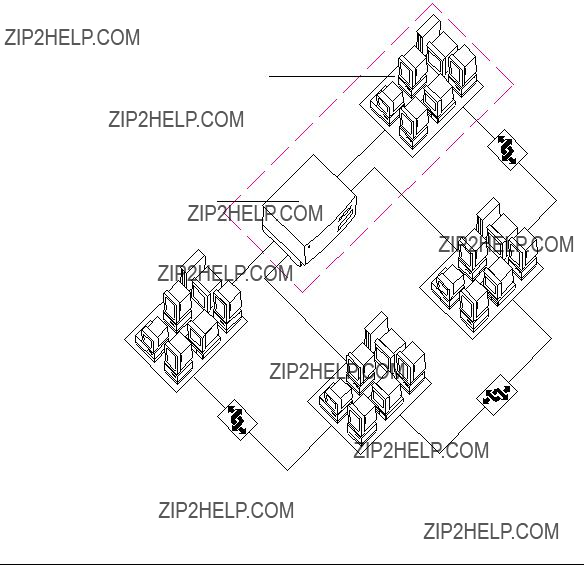
Have users select the server in their own zone
If network segments connected to your server are connected to each other through routers, users will see the server in all the connected zones (in the Chooser). For best performance, make sure that users select in the Chooser the server that resides in the same zone as their own computer.
For instance, in the following illustration, users will be able to see the Archives server in Zones 1, 2, 3 and 4. Users in Zone 1 should log on to the Archives server in Zone 1.
Zone 1
Users in Zone 1 should select the Archives server
visible in the Chooser in Zone 1.
Router
Archives
The server is visible in the Chooser in each zone.
Zone 2
Zone 4
Router
Router
Zone 3
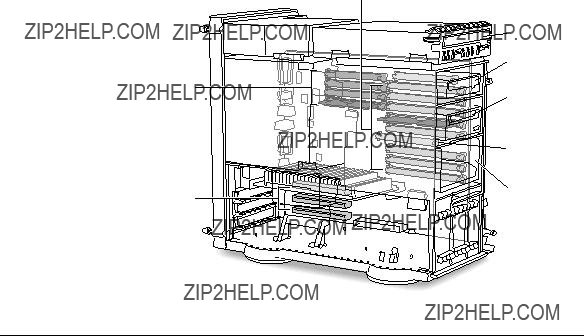
You can expand the capabilities of your server by installing items internally and by connecting external devices. The following figure shows you the location of the Workgroup Server 8550???s internal components. An external view of the server, depicting the ports to which you connect other devices, is shown in the section ???Your Server at a Glance??? in Chapter 1.
IMPORTANT Make sure each device you add is compatible with your server and does not exceed the maximum power allowance for that device. If it is a SCSI, ADB, or internal device, make sure to turn off your server before connecting the device. For further information, consult your
VRAM DIMM connectors
Three PCI expansion slots
Dynamic RAM (DRAM)
DIMM connectors
Floppy disk drive
Internal disk drive bracket
31
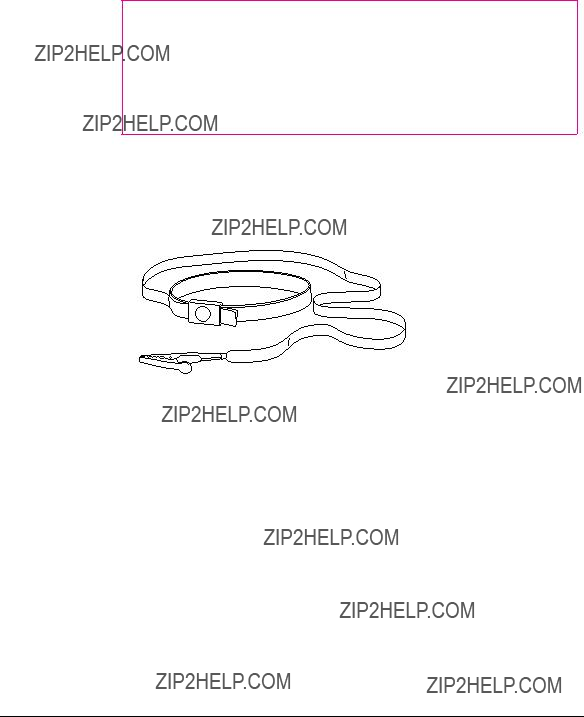
Opening the server safely
WARNING The components in your server, as well as the internal devices that you may install in your server, are very susceptible to damage from electrostatic discharge. When opening your server and while installing internal devices in the server, it is very important to take precautions to protect the server???s components from static electricity damage.
You can take the following preventative measures to avoid electrostatic discharge while you are installing internal devices in your server:
mWear a grounded wriststrap (like the one shown below) while installing internal devices in the server.
mCarefully follow all instructions for discharging static electricity included in the procedures in this chapter.
Follow these steps to open the server:
1Make sure that the server is shut down and that any cables (including the power cord) are disconnected from the server.
2Press the Power button to discharge static electricity.
32 Chapter 3 / Expanding Your Server and Connecting Other Equipment
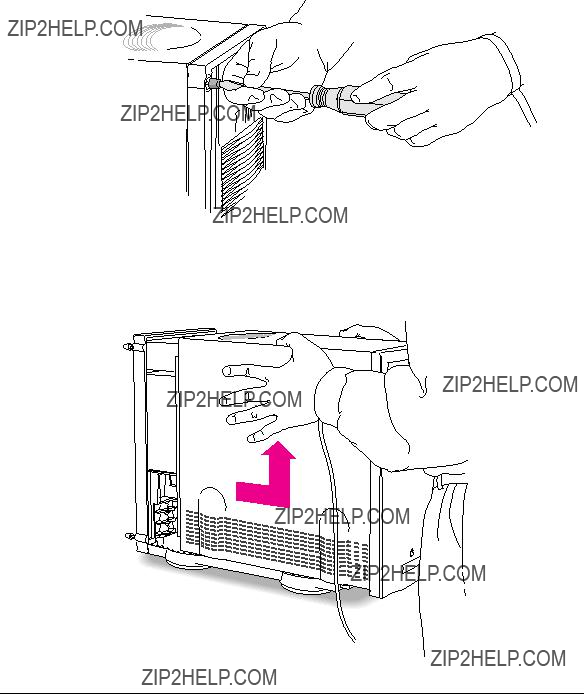
3Loosen the four large screws at the corners of the back panel.
Do not remove the screws or the back panel.
4Remove the cover from the server.
Slide the cover away from the back panel an inch or two. Then raise the cover straight up and off the server.

Installing an expansion card
You can install printed circuit boards (called cards) for networking and communications, SCSI acceleration, video and graphics applications, or other purposes. The cards fit into connectors, called expansion slots, inside the server.
Your Workgroup Server 8550 has three expansion slots, each designed to accept a Peripheral Component Interconnect (PCI) card. Install only expansion cards that come with Mac OS drivers and are compliant with the PCI 2.0 standard. NuBus cards cannot be used in your server???s expansion slots. There is also an expansion slot that contains the server???s processor card. (The processor card can be upgraded by replacing it with a more powerful processor card.)
WARNING To avoid damaging your server and expansion card, do not attempt to install any expansion card without first checking the documentation for that card. If the documentation specifies that an
Power requirements
The combined power consumption of expansion cards must not exceed the limits specified for your Workgroup Server 8550. If you have more than one expansion card installed, check the information that came with your cards to make sure that their power consumption is within the limits specified in Appendix B, ???Technical Information.???
34 Chapter 3 / Expanding Your Server and Connecting Other Equipment

Installing a PCI expansion card
IMPORTANT Some cards may need to be installed by an
Follow these steps to install an expansion card.
1Carefully follow the instructions provided earlier in this chapter for opening the server safely.
Remember to wear a grounded wriststrap while installing an expansion card.
2Touch the metal part of the power supply case inside the server to discharge static electricity.
Always do this before you touch any parts or install components inside the server.
Power supply

3Lower the retainer.
Squeeze the sides of the retainer and pull down.
To lower the retainer, squeeze the sides to unlatch it.
4Being careful not to touch the sharp edges, pull out the metal access port cover behind the expansion slot you want to use, and set the access port cover aside.
1 Press apart the two levers that are next to the card access port to release the access port cover.
2 Slide the access port cover out and away from the access port.
36 Chapter 3 / Expanding Your Server and Connecting Other Equipment
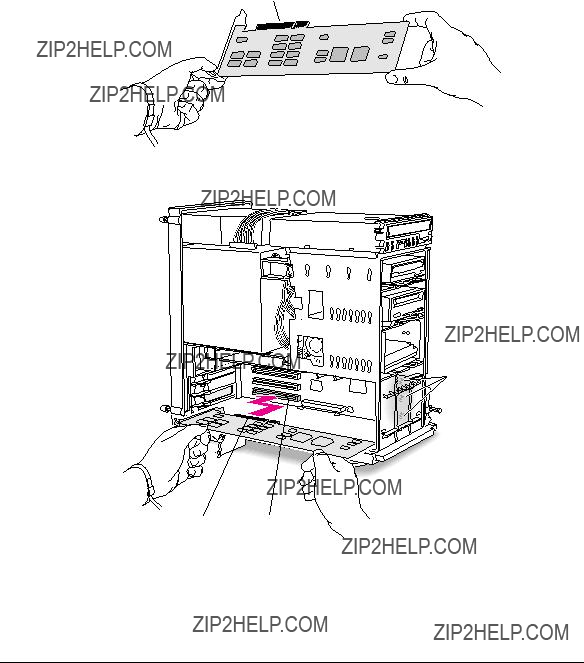
5To protect your card, touch the metal part of the power supply case to discharge static electricity again, as in step 2, and then remove the card from its
Hold the card by its edges to avoid touching the connector.
Connector
6 Align the connector end of the card with the expansion slot.
If your expansion card is

7Press the card ???rmly until the connector is seated.
m Slide the card between the two levers that held the access port cover you removed earlier. You may need to press the levers apart slightly to guide the card between them.
m Don???t force the card. If you meet a lot of resistance, pull the card out and try again.
m To see if the card is properly connected, pull it gently. If it resists and stays in place, it???s connected. (Make sure you don???t pull the card so much that you accidentally disconnect it.)
If you have other cards to install, put them in now by repeating steps 4 through 7.
8Replace the retainer.
This guide on the retainer engages the processor card in the server.
When the card is properly seated, the levers snap into place and secure the card.
38 Chapter 3 / Expanding Your Server and Connecting Other Equipment
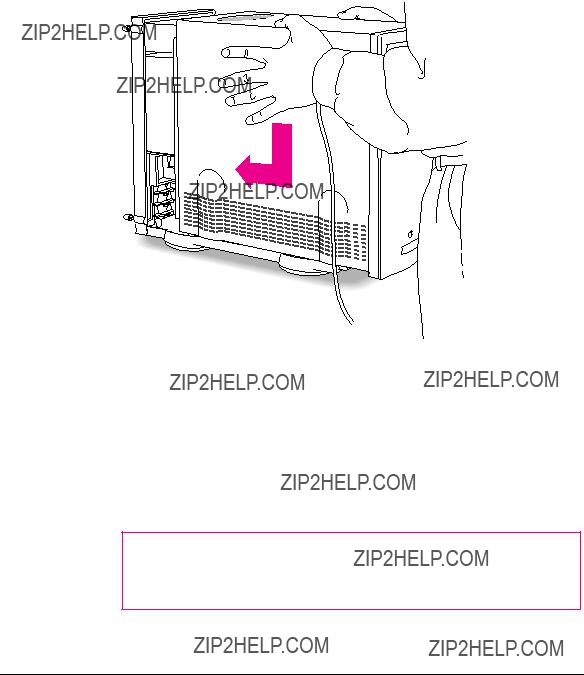
9Replace the cover on the server.
Lower the cover all the way down onto the case. Push the cover toward the back until it touches the back panel.
10Tighten the screws on the back panel.
You are now finished installing the card. If a software driver was included with your expansion card (on a floppy disk), after you finish setting up your server and turn it on, you will need to install the driver.
Return to Chapter 1 to complete the steps for setting up and turning on your server, and then, if you need to install driver software, refer to the documentation that accompanied the expansion card and to ???Installing Device Drivers??? in Chapter 1 of the Workgroup Server Administrator??? Guide.
WARNING Never turn on your server unless all of its internal and external parts are in place. Operating the server when it is open or missing parts can be dangerous, and can damage your server.

Upgrading the processor
Your server???s processor can be upgraded with the installation of a processor upgrade card.
To upgrade the processor, remove the old processor card following the instructions earlier in this chapter for opening the server safely. Then, the new processor card can be installed following the procedure in this chapter for installing expansion cards. (Note that an access port cover does not need to be removed as described in step 4 of ???Installing a PCI Expansion Card??? earlier in this chapter.)
IMPORTANT The processor card can be damaged by static electricity. To avoid damaging the card, hold it only by the
Refer to the documentation that came with the processor upgrade card for important installation instructions specific to the card.
Processor card (behind retainer)
40 Chapter 3 / Expanding Your Server and Connecting Other Equipment

Expanding memory
Additional memory can be installed in your server. Memory for your server is provided in packages called Dual Inline Memory Modules (DIMMs). Appendix B, ???Technical Information,??? describes how much additional memory can be installed in the server.
Adding dynamic
You can also improve your server???s performance by upgrading the Level 2 (L2) cache with a
The memory used to display images on the screen (called video RAM, or VRAM) can also be expanded by installing DIMMs. VRAM DIMMs must be installed in pairs.
It is very important that the DIMMs be correctly installed in your Workgroup Server 8550. Incorrect installation can result in errors, unpredictable results, and damage to your equipment and data.
WARNING To avoid damage to your server, Apple recommends that only an
Expanding memory 41

Connecting hard disks and other SCSI devices
Your Workgroup Server 8550 has two buses for connecting devices that use the Small Computer System Interface (SCSI, pronounced
IMPORTANT Before connecting a device to your server, be sure that the server (and any other device already connected to it) is turned off. Read the instructions in this section and the instructions that came with your hard disk or other SCSI device before connecting it to your server.
Bus A is the internal Fast
Bus B is an internal/external
SCSI icon

 SCSI port
SCSI port
You can connect SCSI devices to the SCSI port in a chain. The first device in the chain plugs into the SCSI port; the second device plugs into the first device, and so on. If the only device connected to your server???s
internal/external SCSI bus is its
42 Chapter 3 / Expanding Your Server and Connecting Other Equipment

Devices on the same SCSI bus must have unique ID numbers (however, devices on different SCSI buses may use the same SCSI ID number).
Setting up a SCSI device to use with your server involves:
msetting the device???s SCSI ID number
mphysically connecting the device to your server (including appropriate termination)
minstalling any necessary device drivers (and restarting your system)
Setting the SCSI ID number
If you have a SCSI device not sold by Apple, see the instructions that came with that device for information on setting its SCSI ID number.
WARNING Each SCSI device connected to your server must have its own, unique SCSI ID number. Using two or more devices with the same ID number (on the same SCSI bus) can cause your equipment to malfunction.
If you have an Apple SCSI device, set the SCSI ID number as follows:
1Make sure your server is shut down and the SCSI device is turned off.
2Choose a number between 0 and 6 that doesn???t duplicate the ID of any other SCSI device connected to your server on the same SCSI bus.
The following table shows the server???s default SCSI ID numbers as well as the SCSI ID numbers available for you to use on the internal/external bus.
Connecting hard disks and other SCSI devices 43

On the internal/external bus, you can use SCSI ID numbers 0, 4, 5, 6. The secondary hard disk (in the top bay of the internal disk drive bracket), the optional
3 Locate the ID number switch on the back of your SCSI device.
SCSI ID switch
4Push the ID switch repeatedly until the number you want appears.
On some SCSI devices, the ID number switch is inside a small hole. Insert a straightened paper clip to push the switch.
Follow the instructions in the next section to install an additional hard disk in the internal disk drive bracket. To replace or install a drive in the server???s auxiliary bay, see ???Installing a Drive in the Auxiliary Bay.??? To connect external devices to your server, see ???Connecting an External SCSI Device.???
44 Chapter 3 / Expanding Your Server and Connecting Other Equipment

Installing an additional hard disk in the internal disk drive bracket
You can add a secondary internal hard disk in the top bay of the server???s internal disk drive bracket (shown in the external view of the server in the section ???Your Server at a Glance??? in Chapter 1).
Follow these steps to install an additional internal hard disk.
1Open the server by following the instructions in the section ???Opening the Server Safely??? earlier in this chapter.
Remember to wear a grounded wriststrap while installing an internal hard disk.
2Touch the metal part of the power supply case inside the server to discharge static electricity.
Always do this before you touch any parts or install components inside the server.
Power supply
Connecting hard disks and other SCSI devices 45

3Disconnect the SCSI ribbon cable and power cable from the
Termination block
46 Chapter 3 / Expanding Your Server and Connecting Other Equipment
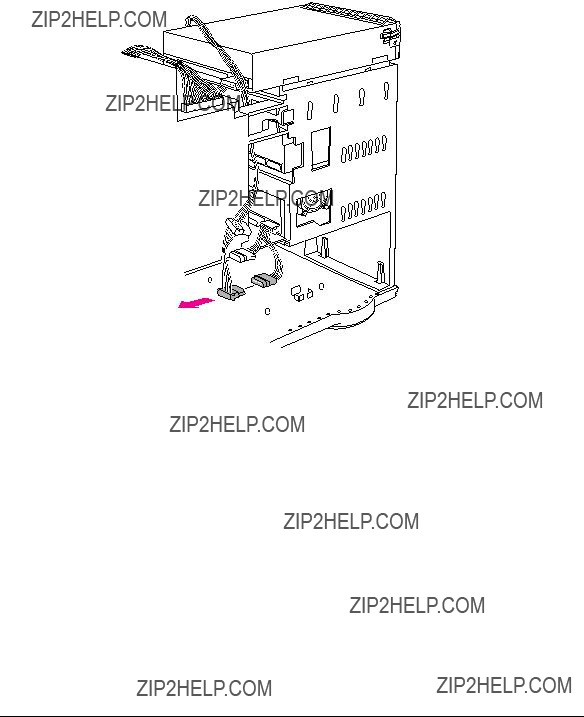
4 Disconnect the power cable from the disk drive bracket.
Connecting hard disks and other SCSI devices 47
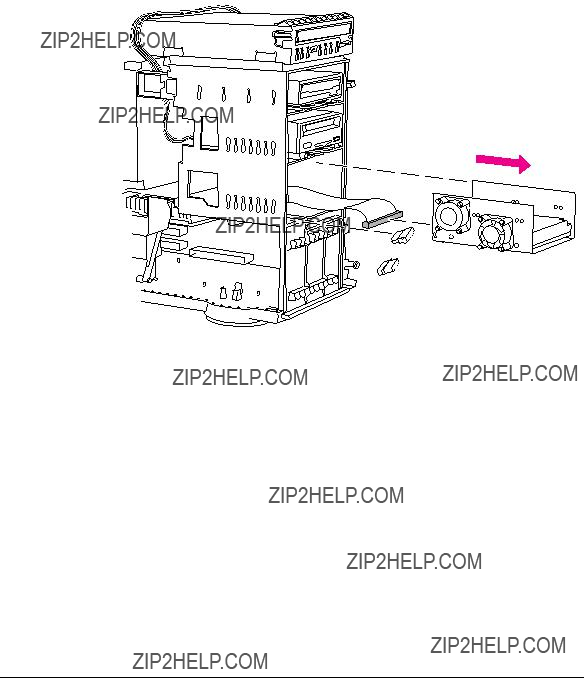
5Slide the disk drive bracket out and disconnect the SCSI ribbon cable from the bottom drive.
To release the bracket, push down the plastic tab just below the bracket.
6Con???rm that the new disk drive is terminated and has its own, unique ID number between 0 and 6.
Since the new disk drive your are installing will be the last internal device on the internal/external SCSI bus, you must make sure that the drive is terminated. To terminate the drive, follow the drive manufacturer???s specifications.
See the previous section, ???Setting the SCSI ID Number,??? for details on selecting and setting ID numbers.
48 Chapter 3 / Expanding Your Server and Connecting Other Equipment
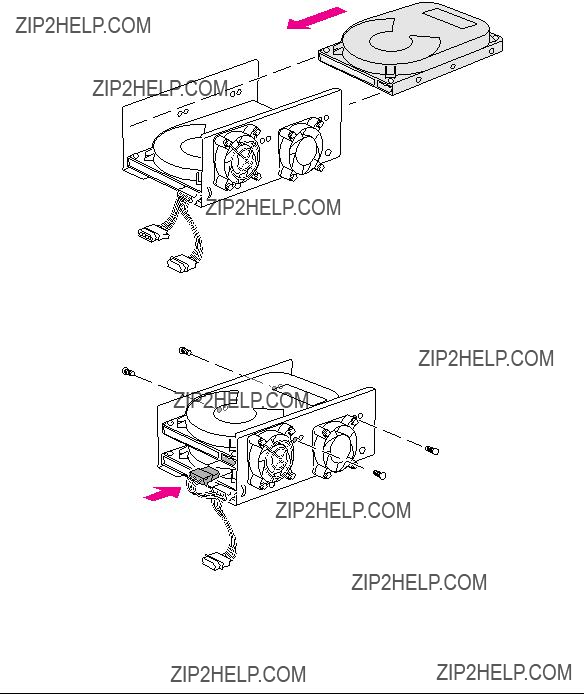
7Slide the new disk drive into the upper bay of the disk drive bracket.
Align the connections on the drive with the back of the bracket.
8Install the four screws in the sides of the bracket and connect the power cable to the upper drive.
Connecting hard disks and other SCSI devices 49

9Connect the SCSI ribbon cables to the two drives and slide the disk drive bracket back into place.
50 Chapter 3 / Expanding Your Server and Connecting Other Equipment

10 Reconnect the power cable to the disk drive bracket.
Connecting hard disks and other SCSI devices 51

11Reconnect the power cable and the SCSI ribbon cable to the
52 Chapter 3 / Expanding Your Server and Connecting Other Equipment

12Replace the cover on the server.
Lower the cover all the way down onto the case. Push the cover toward the back until it touches the back panel.
13Tighten the screws on the back panel.
If a software driver was included (on a floppy disk) with your new hard disk, after you finish setting up your server and turn it on, you will need to install the driver. You may also need to initialize the new hard disk. See the sections ???Installing a Device Driver??? and ???Do You Need to Initialize a Hard Disk???? later in this chapter.
Return to Chapter 1 to complete the steps for setting up and turning on your server.
WARNING Never turn on your server unless all of its internal and external parts are in place. Operating the server when it is open or missing parts can be dangerous, and can damage your server.
Connecting hard disks and other SCSI devices 53

Installing a drive in the auxiliary bay
You can install a digital audio tape (DAT) drive or an additional internal hard disk in your server???s auxiliary bay (shown in the external view of the server in the section ???Your Server at a Glance??? in Chapter 1).
Note: Your server may have come with a DAT drive already installed in the auxiliary bay.
Follow these steps to install (or replace) a drive in your server???s auxiliary bay.
1Open the server by following the instructions in the section ???Opening the Server Safely??? earlier in this chapter.
Remember to wear a grounded wriststrap while installing an internal drive.
2Touch the metal part of the power supply case inside the server to discharge static electricity.
Always do this before you touch any parts or install components inside the server.
Power supply
54 Chapter 3 / Expanding Your Server and Connecting Other Equipment

3If you are replacing a DAT or other drive already in the server???s auxiliary bay, disconnect the SCSI ribbon cable and power cable from the drive in the auxiliary bay.
Connecting hard disks and other SCSI devices 55

4 If you are replacing a drive, slide the drive out of the bay.
5Con???rm that the new drive has its own, unique ID number between 0 and 6.
SCSI ID 2 is recommended for a device in the auxiliary bay. See the section ???Setting the SCSI ID Number??? earlier in this chapter for details.
6Check the termination status of the new drive.
You do not need to terminate a drive installed in the auxiliary bay. The internal end of internal/external SCSI bus should be terminated already, either by the termination block at the end of the SCSI ribbon cable or by a terminated disk drive in the upper bay of the internal disk drive bracket.
Only one internal terminator is allowed on the internal/external SCSI bus. If the drive that you are installing in the auxiliary bay has a
56 Chapter 3 / Expanding Your Server and Connecting Other Equipment

7If necessary, attach the new drive to its bracket.
Follow the instructions that came with the new drive and bracket.
Note: If your new drive did not come with a bracket, see your Apple- authorized dealer for assistance selecting an appropriate bracket for use in the auxiliary bay of your Workgroup Server 8550.
8Slide the new drive assembly into the auxiliary bay.
Connecting hard disks and other SCSI devices 57

9 Connect the power cable and the SCSI ribbon cable to the new drive in the auxiliary bay.
58 Chapter 3 / Expanding Your Server and Connecting Other Equipment
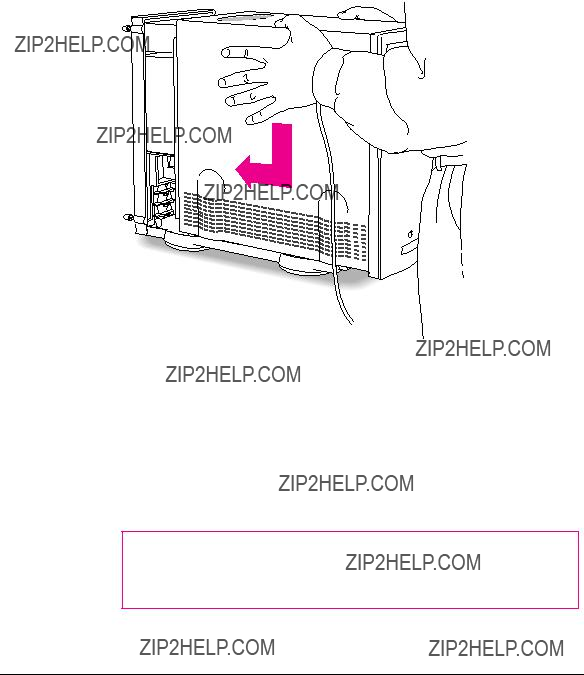
10Replace the cover on the server.
Lower the cover all the way down onto the case. Push the cover toward the back until it touches the back panel.
11Tighten the screws on the back panel.
If a software driver was included (on a floppy disk) with your new drive, after you finish setting up your server and turn it on, you will need to install the driver. You may also need to initialize a newly installed hard disk. See the sections ???Installing a Device Driver??? and ???Do You Need to Initialize a Hard Disk???? later in this chapter.
Return to Chapter 1 to complete the steps for setting up and turning on your server.
WARNING Never turn on your server unless all of its internal and external parts are in place. Operating the server when it is open or missing parts can be dangerous, and can damage your server.
Connecting hard disks and other SCSI devices 59

Connecting an external SCSI device
To connect a SCSI device to the port on your server???s back panel:
1 Make sure that the server and SCSI device are turned off.
WARNING Do not connect or disconnect any device while the device or your server is turned on. Doing so could damage the device, your server, or both.
2Check that the device has its own, unique ID number between 0 and 6.
See the section ???Setting the SCSI ID Number??? earlier in this chapter for details.
3Use a SCSI cable to connect the device either to the server???s SCSI port or to the last SCSI device already in the chain.
If the device is the first or only one you???re connecting, use a SCSI system cable to connect it to the server???s SCSI port.
If the device is not the first one, use a SCSI peripheral interface cable to connect it to the last device in the chain.
IMPORTANT To get the best results with SCSI devices, be sure to use high- quality SCSI cables and check that the total length of the cables in a SCSI chain does not exceed 6 meters (20 feet). Use SCSI cables manufactured by Apple Computer or those of similar quality.
60 Chapter 3 / Expanding Your Server and Connecting Other Equipment

4Make sure that only the last device in the SCSI chain has a terminator and that no other external SCSI device has a terminator.
To ensure accurate transmission of information, a terminator must be at each end of a SCSI chain.
Some external SCSI devices from manufacturers other than Apple have a

 External SCSI terminator
External SCSI terminator
If your SCSI device has a
Note: If only one external device has a
IMPORTANT Always turn on any external SCSI devices connected to your server before turning on the server itself. Otherwise, your server cannot recognize the SCSI devices.
Before using the newly installed SCSI device, you may need to install associated software; see the following section, ???Installing a Device Driver.??? If you installed a hard disk, see also the subsequent section, ???Do You Need to Initialize a Hard Disk????
Connecting hard disks and other SCSI devices 61

Installing a device driver
A SCSI device driver is software that lets the server communicate with a particular SCSI device.
Note: If you have set up your server and connected additional devices, but not yet turned the server on, return to the section ???Plugging In the Server??? in Chapter 1 before installing a device driver.
To install a driver:
mStart up your server, if necessary, and drag the driver icon to the System Folder icon on your startup disk.
Any drivers needed for a SCSI device are usually on a floppy disk that comes with the device. (If no drivers come with the device, then it doesn???t need any.) You may have to restart your server to activate the driver.
Do you need to initialize a hard disk?
You need to initialize a hard disk only in the following cases:
mThe disk is new and uninitialized. Your internal hard disk and most external hard disks are initialized at the factory and do not have to be initialized again. If you are adding a new
mYou???ve experienced repeated errors using this disk. If problems persist after you reinitialize the disk, the disk is in need of servicing.
You use the Apple Drive Setup program to initialize and name a hard disk. Apple Drive Setup is provided as part of your system software and can be found in the Utilities folder on the server???s hard disk as well as on the Workgroup Server Software
If you are using the Apple RAID Software that accompanied your Workgroup Server, you may want to use the Apple RAID Setup program to reinitialize your hard disk(s) to optimize your server???s performance. See the Apple RAID Administrator???s Guide for instructions.
62 Chapter 3 / Expanding Your Server and Connecting Other Equipment

Connecting a printer
Your server has a printer port, which you use to connect a printer to your server.



 Printer port icon
Printer port icon
Printer port
The printer port accepts either a direct cable connection (to printers such as the StyleWriter II) or a network cable connection (to printers such as a LaserWriter Pro or LaserWriter Select).
Follow the instructions that came with your printer when connecting it to your server.
A printer can also be connected to the modem port.
Note: You use the Chooser program to indicate the port you used to connect your printer. (For more information on using the Chooser and printing, see ???Choosing a Printer??? in Chapter 1, ???Configuring Your Server,??? in the
Workgroup Server Administrator???s Guide and the ???Printing and Fonts??? topic in Macintosh Guide, available in the Guide (h) menu.
A GeoPort Telecom Adapter, or similar device, can also be connected to the printer port.
Connecting a printer 63

Connecting an additional monitor
You can use an additional monitor with your server if you install a video expansion card. See ???Installing an Expansion Card??? earlier in this chapter for instructions.
When you connect an additional monitor:
mMake sure that the ventilation openings on the server and the monitors are clear and unobstructed.
mIf necessary, configure the monitor options. See the documentation that accompanied the monitor and ???Configuring Your Monitor??? in Chapter 1 of the Workgroup Server Administrator???s Guide.
mIf there is interference on your screens or on a television or radio near your server, reposition or separate the affected equipment.
Connecting a trackball or other input device
Your server has an Apple Desktop Bus (ADB) port, which you use to connect the mouse, the keyboard, and other input devices such as a trackball, a bar- code reader, or a graphics tablet.
 ADB port icon
ADB port icon
ADB port
You can usually connect up to three ADB devices in a chain to a single port. The exact number depends on how much power the devices require.
IMPORTANT The total power used by all ADB devices connected to your server must not exceed 500 milliamperes (mA). Information about the power requirements of the mouse and keyboard are in Appendix B, ???Technical Information.??? Check the information that came with your other ADB devices for power requirements.
64 Chapter 3 / Expanding Your Server and Connecting Other Equipment
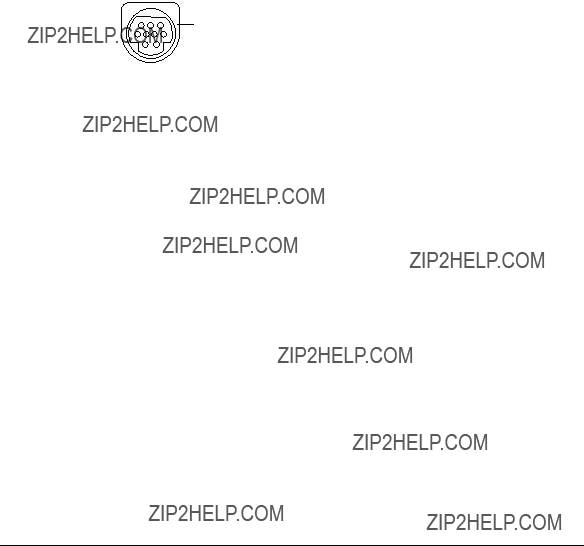
Connecting a modem or GeoPort Telecom Adapter
Your server has a port, called the modem port, which is a serial port designed for use with modems and devices such as the GeoPort Telecom Adapter. These devices, when used with appropriate telecommunications software, take advantage of the server???s
 Modem port icon
Modem port icon
Modem port
You can connect a standard modem to the modem port, using a standard modem cable. To connect an adapter or modem to your server, follow the instructions that came with your adapter or modem.
A GeoPort Telecom Adapter can also be connected to the printer port.
You can also connect a printer to the modem port.
Connecting audio equipment
Your server can play and record stereo sound from a variety of sources. You can listen to or reproduce stereo sound by connecting audio equipment to the sound input and output ports on the server. You can use your internal
For information on using the Mac OS to choose sound input and output options, to record an alert sound, or to play audio CDs, see ???Choosing Sound Devices and Alert Sounds??? in Chapter 1 of the Workgroup Server Administrator???s Guide and the ???Sound??? topic of Macintosh Guide, available in the Guide (h) menu.

About your server???s sound ports
The sound input port is marked with an icon of a microphone. The sound output port is marked with an icon of a speaker.
Sound input port
Sound output port
The server???s sound ports accept these 3.5 mm connectors:
The smaller connector (a ???stereo miniplug???) is found most often on stereo equipment. The slightly longer connector is found on the Apple PlainTalk Microphone and other voice quality microphones. If your equipment has a different type of connector, you can purchase an adapter at an electronics supply store.
66 Chapter 3 / Expanding Your Server and Connecting Other Equipment

Connecting most audio equipment
To play or record sound with your server, you can attach a microphone, amplifier, tape recorder, headphones, or a pair of speakers. (When you have headphones connected, you don???t hear beeps or other server sounds through the
For specific instructions on connecting a microphone, skip to the next section, ???Connecting and Positioning a Microphone.??? For specific instructions on connecting speakers, see ???Connecting External Stereo Speakers??? later in this chapter.
Follow these steps to connect most audio equipment to the server:
1Make sure that the audio equipment has a cable with a stereo miniplug (or extended miniplug) connector.
RCA
Stereo miniplug
2Place the audio equipment near the server.
3Shut down the server and turn off the audio equipment.
4Attach the cable to the audio equipment and to the appropriate sound port on the server.
To hear or record incoming sound on the server using a cable with a stereo miniplug, connect the audio equipment to the sound input port (X).
To record the sound produced by the server or play that sound through external speakers using a cable with a stereo miniplug, connect the audio equipment to the sound output port
5Turn on the server and the audio equipment.
You???re now ready to begin listening to and working with sound. For more information on setting sound options and working with sound, see ???Choosing Sound Devices and Alert Sounds??? in Chapter 1 of the Workgroup Server Administrator???s Guide and the ???Sound??? topic of Macintosh Guide, available in the Guide (h) menu.
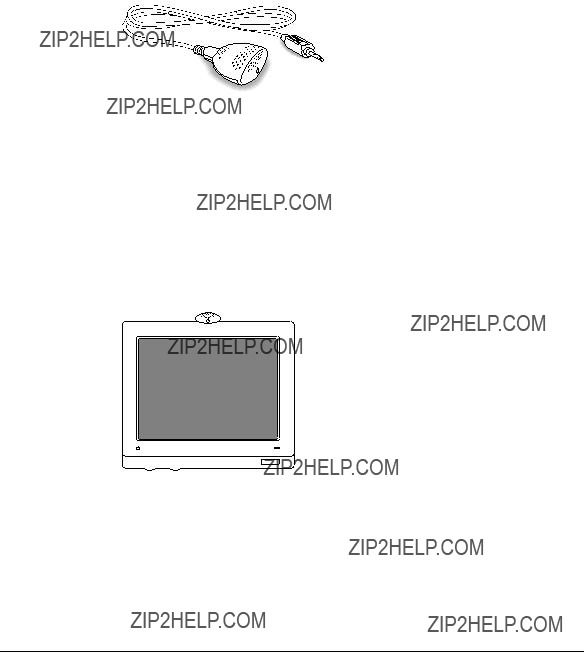
Connecting and positioning a microphone
With appropriate software, you can use an Apple PlainTalk Microphone (or a compatible
Apple PlainTalk Microphone
Do not use the round omnidirectional microphone supplied with some other Macintosh models.
Follow these steps to connect and position the microphone:
1Shut down the server.
2Plug the microphone???s connector into the sound input port (X) on the back of the server.
3Place the microphone at the top center of the monitor, so that the microphone???s Apple (K) icon is facing you.
If you can???t place the microphone on top of the monitor, position the microphone according to these guidelines:
mThe microphone should be between 1 and 3 feet away from you.
mThe microphone should be directly in front of you to minimize the effect of background noises.
68 Chapter 3 / Expanding Your Server and Connecting Other Equipment

4Turn on the server.
You???re now ready to begin using your microphone.
You may want to install software that enables you to give spoken commands to the server, get
Workgroup Server Administrator???s Guide. For further instructions on how to use speech software, see the ???Speech??? topic of Macintosh Guide, available in the Guide (h) menu.
Connecting external stereo speakers
You can take advantage of your server???s stereo sound output by attaching externally powered (amplified) speakers.
1Assemble the speakers and the cable you need.
You need a cable with stereo miniplugs at each end to connect one or both speakers to the server. (Some speakers require a
2Turn off the server.
3Plug a stereo miniplug into the sound output port
4Plug a stereo miniplug into the Audio In port on one of the speakers.
If the speakers take a
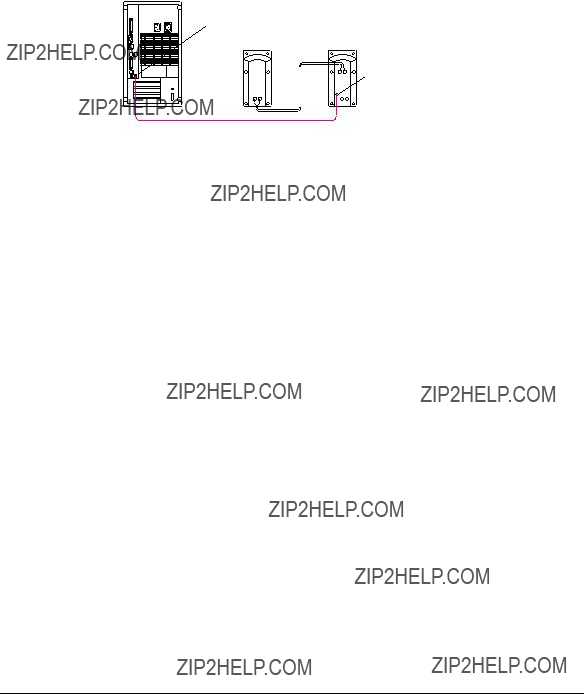
5Connect the speakers together with speaker wires, if necessary.
Your finished connections should look something like this:
6Turn on the server.
Now you hear the server???s sound through the external speakers. (You may also need to set options in the Sound & Displays control panel in order to hear sound through your speakers. To set sound options, see ???Choosing Sound Devices and Alert Sounds??? in Chapter 1 of the Workgroup Server Administrator???s Guide. Refer to the ???Sound??? topic of Macintosh Guide, available in the Guide [h] menu, for more information.)
Note: Use the Sound & Displays control panel to control volume and to set other options for playing sound through the external speakers. If you are playing an audio CD, you may also need to adjust the volume control in the program you???re using to play CDs.
70 Chapter 3 / Expanding Your Server and Connecting Other Equipment

Appendix A Safety, Maintenance, and Health Information
Important server safety instructions
For your own safety and that of your equipment, always take the following precautions.
Turn off the server and disconnect the power plug (by pulling the plug, not the cord) if any of the following conditions exists:
mThe power cord or plug becomes frayed or otherwise damaged.
mYou spill something into the case.
mYour server is exposed to rain or any other excess moisture.
mYour server has been dropped or the case has otherwise been damaged.
mYou suspect that your server needs service or repair.
mYou want to clean the case (use only the recommended procedure described later in this section).
For additional safety:
mIf you ever need to remove the cover of your server, replace it before you use the server.
mNever turn on your server with any of the internal parts removed.
mNever turn on your server with any parts of the external closure removed.
71

Be sure that you always do the following:
mKeep your server away from sources of liquids, such as wash basins, bathtubs, shower stalls, and so on.
mProtect your server from dampness or wet weather, such as rain, snow, and so on.
mRead all the installation instructions carefully before you plug your server into a wall socket.
mKeep these instructions handy for reference by you and others.
mFollow all instructions and warnings dealing with your system.
WARNING Electrical equipment may be hazardous if misused. Operation of this product, or similar products, must always be supervised by an adult. Do not allow children access to the interior of any electrical product and do not permit them to handle any cables.
To clean the case, do the following:
1Turn off the server and then disconnect the power plug. (Pull the plug, not the cord.)
2Wipe the surfaces lightly with a clean, soft cloth dampened with water.
IMPORTANT If you have a problem with your server and nothing in the manuals that came with the server solves the problem, consult the service and support information that came with your server for information on how to contact an
Handling your computer equipment
Follow these guidelines for handling your server and its components:
mWhen setting up your server, place components on a sturdy, flat surface, and carefully follow all setup instructions.
mWhen connecting or disconnecting a cable, always hold the cable by its connector (the plug, not the cord).
72 Appendix A / Safety, Maintenance, and Health Information

mTurn off your server and all its components before connecting or disconnecting any cables to add or remove any component. Failure to do so could seriously damage your equipment.
mNever force a connector into a port. If the connector and port do not join with reasonable ease, they probably don???t match. Make sure that the connector matches the port and that you have positioned the connector correctly in relation to the port.
mTake care not to spill any food or liquid on the server, keyboard, mouse, or other components. If you do, turn your server off immediately and unplug it before cleaning up the spill. Depending on what you spilled and how much of it got into your equipment, you may have to bring your equipment to an
mProtect the server and its components from direct sunlight and rain or other moisture.
mKeep all ventilation openings clear and unobstructed. Without proper air circulation, components can overheat, causing damage or unreliable operation.
Handling the monitor
Follow these procedures for handling a monitor:
mTurn down the screen brightness control if you leave the server turned on for extended periods. If the brightness is not turned down, the image on the screen could ???burn in??? and damage the screen.
You can also use a
mMake sure that the ventilation openings on the server and the monitor are clear and unobstructed.
mIf there is interference on the monitor???s screen or on a television or radio near your server, move the affected equipment farther away.

Handling the keyboard
Take care not to spill any liquid on the keyboard. If you do, turn off your server immediately.
mIf you spill liquid that is thin and clear, unplug the keyboard, turn it upside down to let the liquid drain out, and let it dry for 24 hours at room temperature. If, after you take these steps, the keyboard doesn???t work, take it to an
mIf you spill liquid that is greasy, sweet, or sticky, unplug the keyboard and take it to an
Handling floppy disks
Store disks at temperatures between 50?? F and 125?? F.
125?? F (52?? C)
50?? F (10?? C)
74 Appendix A / Safety, Maintenance, and Health Information
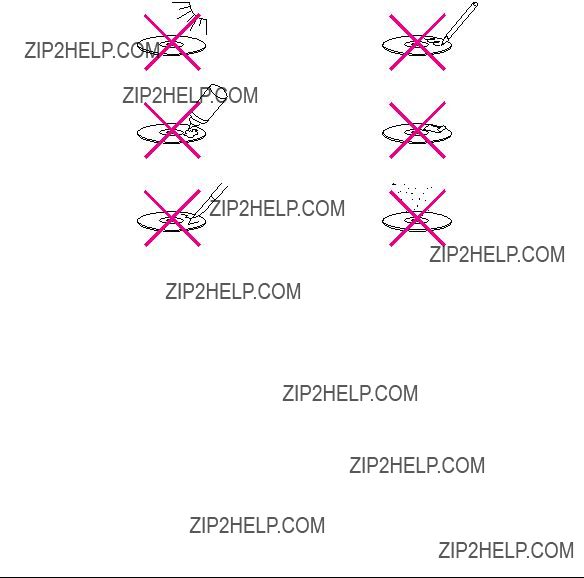
Handling
Keep these important safety instructions in mind as you use
mHold a disc by the edges or by one edge and the center hole. Do not touch the disc surface.
mTo clean discs, wipe the shiny surface with a soft damp cloth, working in straight lines from center to edge. Do not use any form of cleaning agent.
mTo avoid damage to your discs, keep these points in mind:
Other important safety instructions to keep in mind as you use your
mPosition your server so that when the tray opens, it doesn???t bump into anything.
mDo not leave the disc tray open. If dust gets on the lens of the
mDo not put anything (for instance, a cup) on top of the tray when it is open.
mDo not force the tray open by hand.
mDo not wipe the lens with a paper towel or other abrasive surface. If you need to clean the lens, see an
mNever transport your server with a disc inside the

mKeep your computer equipment away from any source of liquid (such as wash basins, bathtubs, and shower stalls). If you drink coffee or other beverages while you???re at your server, take care not to spill.
mAvoid exposing your equipment to damp or wet weather. If your system is near a window, be sure the window is closed in rainy weather.
The tray on your
Ejecting a disk
For instructions on ejecting a ???oppy disk, a
If you can???t eject a floppy disk
If you can???t eject a floppy disk in the usual way, try the following in order:
mHold down the x (Command) and Shift keys and press the number 1 key on your keyboard to eject a disk in the internal disk drive.
mShut down the server. If the disk isn???t ejected, then hold down the button on your mouse or other pointing device while you restart the server.
mLocate the small hole near the disk drive???s opening, and carefully insert the end of a large straightened paper clip into it. Push gently until the disk is ejected. Do not use excessive force.
If nothing works, take the server or disk drive to your
76 Appendix A / Safety, Maintenance, and Health Information

Power supply
The power supply in your server is a
Cleaning your equipment
Follow these general rules when cleaning the outside of your server and its components:
mUse a damp, soft,
mDon???t use aerosol sprays, solvents, or abrasives.
Cleaning the server case
To clean the case, do the following:
1Turn off the server and disconnect the power plug. (Pull the plug, not the cord.)
2Wipe the surfaces lightly with a clean, soft cloth dampened with water.
Cleaning the monitor
To clean the screen, put household glass cleaner on a soft cloth and wipe the screen. Don???t spray the cleaner directly on the screen, because the liquid might drip into the monitor or server.
Cleaning the mouse
The mouse contains a small ball that must roll smoothly for the mouse to work properly. You can keep this ball free of dirt and grease by using the mouse on a clean,
You need a few cotton swabs and a clean, soft,
1 Turn off your server.
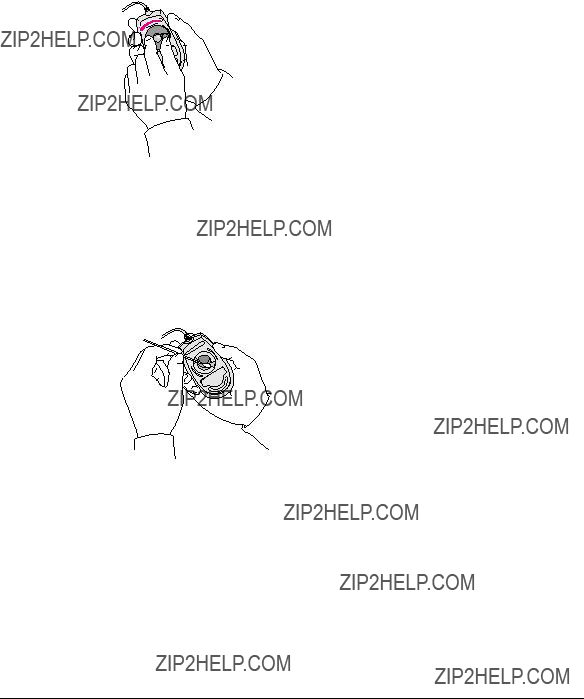
2Turn the mouse upside down and turn the plastic ring on the bottom counterclockwise to disengage it.
If you have an older mouse, you may need to press the plastic ring (rather than turn it) to disengage it.
3Turn the mouse right side up with one hand and catch the ring and the ball with your other hand.
4Clean the three small rollers inside the mouse with a cotton swab moistened with water.
Rotate the rollers to clean all around them.
5Wipe the mouse ball with a clean, soft, dry, and
6If necessary, wash the mouse ball with warm soapy water (use a mild soap such as a dishwashing liquid) and then dry the mouse ball thoroughly.
7Gently blow into the mouse case to remove any dust that has collected there.
8Put the ball and the ring back in place.
Your mouse should roll smoothly across your mouse pad or desk. If it doesn???t, repeat these instructions carefully.
78 Appendix A / Safety, Maintenance, and Health Information
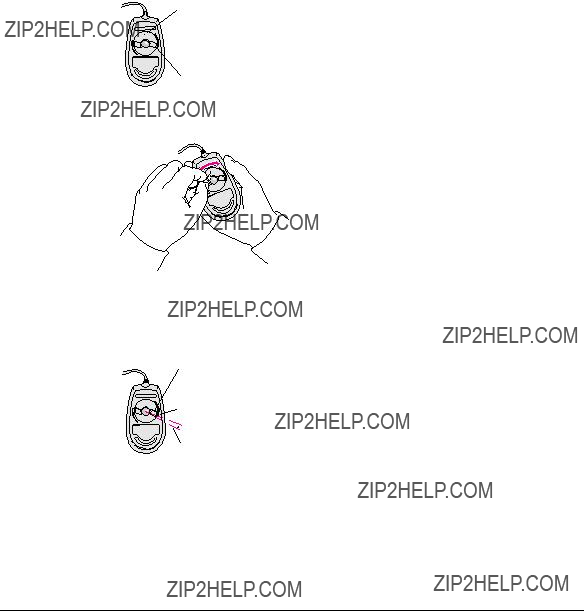
Locking and unlocking the mouse
Some mouse devices can be locked so that the ball can???t be removed. A locking mouse has a small hole on the plastic ring.
To lock the mouse, follow these steps:
1 Insert a straightened paper clip into the hole on the plastic ring.
Insert a straightened paper clip into this hole.
(The hole may be located here on your mouse.)
2 Press down on the paper clip while you turn the ring clockwise.
Turn the ring a very short distance, until it stops. When the recessed area on the ring is not lined up with the recessed area surrounding the ring, the mouse is locked.
Recessed area on ring
Recessed area surrounding ring
The mouse ring is locked when the recessed area on the ring does not line up with the recessed area surrounding the ring.

To unlock the mouse, follow these steps:
1 Insert a straightened paper clip into the hole on the plastic ring.
Insert a straightened paper clip into this hole.
(The hole may be located here on your mouse.)
2 Press down on the paper clip while you turn the ring counterclockwise.
Turn the ring a very short distance. When the recessed area on the ring is lined up with the recessed area surrounding the ring, the mouse is unlocked.
Recessed area on ring
Recessed area surrounding ring
The mouse ring is unlocked when the recessed area on the ring lines up with the recessed area surrounding the ring.
80 Appendix A / Safety, Maintenance, and Health Information

Muscle soreness, eye fatigue, and other discomforts and injuries sometimes associated with using computers can occur from performing any number of activities. In fact, misuse of the same muscles during multiple activities can create a problem that might not otherwise exist. For example, if you engage in nonwork activities that involve repetitive stress on the
The most common health effects associated with using a computer are musculoskeletal discomfort and eye fatigue. We???ll discuss each area of concern below. For information about electric and magnetic emissions, look in the reference material that came with your server.
Musculoskeletal discomfort
As with any activity that involves sitting for long periods of time, using a computer can make your muscles sore and stiff. To minimize these effects, set up your work environment carefully, using the guidelines that follow, and take frequent breaks to rest tired muscles. To make working with your computer more comfortable, allow enough space in your work area so that you can change position frequently and maintain a relaxed posture.
Another type of musculoskeletal concern is repetitive stress injuries (RSIs), also known as cumulative trauma disorders (CTDs). These problems can occur when a certain muscle or tendon is repeatedly overused and forced into an unnatural position. The exact causes of RSIs are not totally understood, but in addition to awkward posture, such factors as the amount of repetition, the force used in the activity, the individual???s physiology, workplace stress level, and lifestyle may affect the likelihood of experiencing an RSI.

RSIs did not suddenly arise when computers were invented; tennis elbow and writer???s cramp, for example, are two RSIs that have been with us for a long time. Although less common than other RSIs, one serious RSI discussed more often today is a wrist problem called carpal tunnel syndrome, which may be aggravated by improper use of computer keyboards. This nerve disorder results from excessive pressure on the median nerve as it passes through the wrist to the hand.
This section offers advice on setting up your work area to enhance your comfort while you use your computer. Since the effects of repetitive movements associated with using a computer can be compounded by those of other work and leisure activities to produce or aggravate physical problems, proper use of your computer system must be considered as just one element of a healthy lifestyle.
No one, of course, can guarantee that you won???t have problems even when you follow the most expert advice on using computer equipment. You should always check with a qualified health specialist if muscle, joint, or eye problems occur.
Eye fatigue
Eye fatigue can occur whenever the eyes are focused on a nearby object for a long time. This problem occurs because the eye muscles must work harder to view an object that???s closer than about 20 feet (6 meters). Improper lighting can hasten the development of eye fatigue. Although eye fatigue is annoying, there???s no evidence that it leads to permanent damage.
Whenever you???re engaged in an activity that involves
To prevent discomfort and eye fatigue:
mArrange your workspace so that the furniture is properly adjusted for you and doesn???t contribute to an awkward working posture.
mTake frequent short breaks to give your muscles and eyes a chance to rest.
82 Appendix A / Safety, Maintenance, and Health Information

Arranging your office
Here are some guidelines for adjusting the furniture in your office to accommodate your physical size and shape.
mAn adjustable chair that provides firm, comfortable support is best. Adjust the height of the chair so that your thighs are horizontal and your feet flat on the floor.
The back of the chair should support your lower back (lumbar region). Follow the manufacturer???s instructions for adjusting the backrest to fit your body properly.
mWhen you use the computer keyboard, your shoulders should be relaxed. Your upper arm and forearm should form an approximate right angle, with your wrist and hand in roughly a straight line.
You may have to raise your chair so that your forearms and hands are at the proper angle to the keyboard. If this makes it impossible to rest your feet flat on the floor, you can use a footrest with adjustable height and tilt to make up for any gap between the floor and your feet. Or you may lower the desktop to eliminate the need for a footrest. Another option is to use a desk with a keyboard tray that???s lower than the regular work surface.
mPosition the mouse at the same height as your keyboard. Allow adequate space to use the mouse comfortably.
Shoulders relaxed
Forearms and hands in a straight line
Forearms level or tilted up slightly
Lower back supported
Thighs horizontal
Top of the screen at or slightly below eye level (You may need to adjust the height of your monitor by placing something under it or by raising your work surface.)
Screen positioned to avoid reflected glare
Clearance under work surface
Feet flat on the floor

mArrange the monitor so that the top of the screen is slightly below your eye level when you???re sitting at the keyboard. The best distance from your eyes to the screen is up to you, although most people seem to prefer 18 to 28 inches (45 to 70 cm).
mPosition the monitor to minimize glare and reflections on the screen from overhead lights and windows. You may want to use a tiltable monitor stand. The stand lets you set the monitor at the best angle for viewing, helping to reduce or eliminate glare from lighting sources you can???t move.
Avoiding fatigue
mChange your seated position, stand up, or stretch whenever you start to feel tired. Frequent short breaks are helpful in reducing fatigue.
mUse a light touch when typing or using a mouse and keep your hands and fingers relaxed.
mSome computer users may develop discomfort in their hands, wrists, or arms after intensive work without breaks. If you begin to develop chronic pain or discomfort in your hands, wrists, or arms, consult a qualified health specialist.
mAllow adequate workspace so that you can use your keyboard and mouse comfortably. Place papers or other items so that you can view them easily while using your computer. A document stand may make reading papers more comfortable.
mEye muscles must work harder to focus on nearby objects. Occasionally focus your eyes on a distant object, and blink often while you work.
mClean your screen regularly. Keeping the screen clean helps reduce unwanted reflections.
84 Appendix A / Safety, Maintenance, and Health Information

What about electromagnetic emissions?
There has been recent public discussion of the possible health effects of prolonged exposure to extremely low frequency (ELF) and very low frequency (VLF) electromagnetic fields. Such fields are associated with electromagnetic sources such as television sets, electrical wiring, and some household
Apple has reviewed scientific reports and sought the counsel of government regulatory agencies and respected health organizations. Based on the prevailing evidence and opinions, Apple believes that the electric and magnetic fields produced by computer monitors do not pose a health risk.
In response to those customers who wish to reduce their exposure to electromagnetic fields, Apple has lowered the emission levels of our products. We are also actively encouraging further scientific research so we can continue to promote the health and safety of our customers and employees.

Appendix B Technical Information
This appendix contains the following technical information about your Workgroup Server 8550:
mExpanding your server
mSpecifications
87

Expanding your Workgroup Server 8550
Your Workgroup Server 8550 was designed to grow with your
However, you must make sure that each component you add is compatible with your server and does not exceed its maximum power allowance. Follow the specifications in this appendix carefully. Your dealer or the manufacturer of a component can also provide compatibility details.
Apple recommends that you have the following equipment installed by an
madditional dynamic
madditional video RAM (VRAM), up to a total of 4 MB
madditional L2 cache memory, up to a total of 4 MB
You can install the following yourself:
mup to three PCI cards, such as a specialized communications card
many additional internal 3.5- or
See Chapter 3, ???Expanding Your Server and Connecting Other Equipment,??? for instructions on adding components to your server.
88 Appendix B / Technical Information

Specifications
This section lists the hardware specifications for the Workgroup Server 8550.
Main unit
Processor
A PowerPC 604 processor with the following features:
m132 megahertz (MHz) clock speed
m
m44 MHz system bus
mfully upgradable (with a processor card upgrade)
Memory
m24 MB of DRAM supplied in removable DIMMs, expandable to a maximum of 512 MB
m2 MB of
m4 MB of
m8 kilobytes (K) of nonvolatile parameter memory
mone 512K DIMM of static RAM (SRAM) used as an L2 cache, upgradable to 4 MB
DRAM, VRAM, and cache configurations
You can have
Specifications 89

WARNING To avoid damage to your server, Apple Computer recommends that only an
DRAM configurations
Your server can use any DRAM configuration with DIMMs of these sizes: 8, 16, 32, or 64 MB. The exact configuration depends on the density of the DRAM chips that are mounted on the DIMMs.
You can increase your server???s DRAM to up to 512 MB. The main logic board has eight slots where DIMMs can be installed. To increase DRAM to
the maximum of 512 MB, have an
Note: 128 MB DIMMs can fit in the server???s memory slots to increase DRAM to as much as 1 gigabyte (GB). These DIMMs have not been tested for use with Workgroup Server 8550 systems, however.
IMPORTANT The DIMMs should be
90 Appendix B / Technical Information

VRAM configurations
VRAM, like standard DRAM, is also provided in DIMMs. Your server comes with 2 MB of VRAM installed in two 1 MB DIMMs. (These DIMMs are installed in bank 1.) Your server???s VRAM can be expanded to a maximum of 4 MB by adding two 1 MB DIMMs to bank 2. Both DIMMs must be added at the same time.
IMPORTANT The VRAM DIMMs must be
Cache configurations
Your server has a 512K L2 cache. You can upgrade the L2 cache to a maximum of 4 MB by replacing the existing 512K cache DIMM with a
Adding DRAM
If you decide to have additional DRAM installed in your server, the DIMMs can be installed one at a time in any order in any of the memory slots.
However, if you wish to take advantage of your server???s memory interleaving capability, which provides maximum performance, you must have the DIMMs installed in pairs and in paired slots. (A1 and B1 are the first pair of slots, A2 and B2 are the second, and so on.) Memory interleaving allows the server to read or write to its memory at the same time that other memory reads or writes are occurring, thus providing faster performance.
Specifications 91

*When installing DRAM, for best performance, fill slots A1 and B1, then A2 and B2, then A3 and B3, and so forth.
Graphics modes
The table on the following page shows the image sizes for monitors that can be connected to the monitor port, along with the number of colors or grays supported with 2 MB of VRAM and with the optional expansion to 4 MB of VRAM.
There are also many special PCI monitor cards available from other manufacturers that can support other monitors and special video requirements. See your
Note: On some monitors from manufacturers other than Apple, the connector pinout designates one pin for both green video and timing synchronization. These ???sync on green??? monitors are not compatible with Workgroup Server 8550 systems. If you???re not sure what type of monitor you have, check with your dealer.
92 Appendix B / Technical Information

Colors or grays supported
*Viewable Image Size
**256=image depth of 8 bits, thousands=image depth of 16 bits, millions=image depth of 32 bits.
***Refer to the manual that came with your monitor to determine VIS. N/A=not available
Specifications 93

Internal disk drives
mApple SuperDrive 1.4 MB
mInternal Apple SCSI hard disk drive bracket, which accomodates two
mInternal
mOptional internal
A combination of up to eight internal and external SCSI devices can be used.
Clock/calendar
m CMOS custom circuitry with
Keyboard
m Supports all Apple Desktop Bus (ADB) keyboards.
Mouse
m Supports all models of the ADB mouse.
Interfaces
mOne Apple Desktop Bus (ADB) port supporting up to three ADB input devices (such as a trackball, keyboard, or mouse)
mMonitor port supporting color and grayscale monitors of various sizes and resolutions. (See ???Graphics Modes??? earlier in this appendix.)
mThree internal expansion slots supporting Peripheral Component Interconnect (PCI) expansion cards. Install only expansion cards that come with Mac OS drivers and that are compliant with the PCI 2.0 standard. NuBus cards cannot be used in these expansion slots.
94 Appendix B / Technical Information

mTwo
mOne
mOne
mOne 3.5 mm sound output port for headphones or
mOne 3.5 mm sound input port for stereo sound input. The sound input port supports the Apple PlainTalk Microphone that comes with some Macintosh computers. The sound input port also supports a standard stereo
(the round microphone shipped with some earlier models of Macintosh) or the attenuated RCA adapter provided with some models of Macintosh.
mOne internal/external SCSI interface that supports up to six external SCSI devices, or one internal device plus five external SCSI devices (the
IMPORTANT Some older SCSI devices may require updated drivers. (A ???driver??? is special software that is installed in your System Folder.) Contact the device manufacturer for information on obtaining driver software.
mOne internal Fast
Specifications 95

Audio system
mCustom sound circuitry, including stereo generator
m
mSample rates of 44.1 and 22.05 kilohertz (kHz).
Typical specifications
mSound input connector line level: 2.8 volts
mSound output connector line level: 2.7 Vpp nominal, into
mSound input
mSound output SNR: >84 dB
mBandwidth: 10 Hz to 18 kHz (+0.1 dB,
The following graphs show typical data for the Workgroup Server 8550. (Your server???s data may vary, depending on the equipment you have connected.)
Digital  RCA output
RCA output
Frequency (Hz)
96 Appendix B / Technical Information

Frequency Response
Digital  RCA output
RCA output
Total Harmonic Distortion vs. Amplitude
Digital  RCA output
RCA output
1.02.0 3.0
Amplitude (Vpp)
Specifications 97
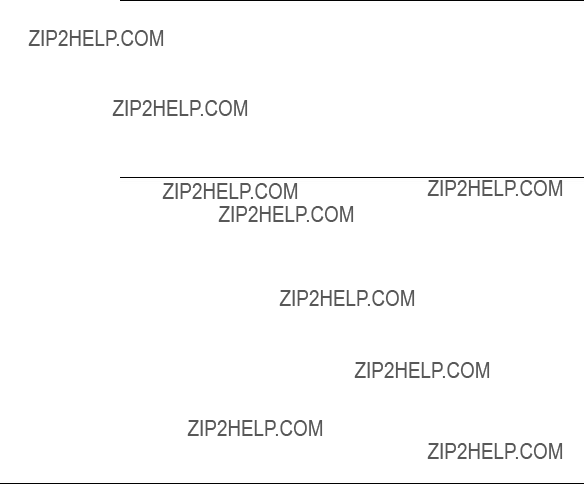
AC line input
mLine voltage:
mFrequency:
mPower: 340 watts maximum continuous; 520 watts peak input.
AC line output
mOutput receptacle:
DC power
m Continuous output: 225 watts.
*Total power output cannot exceed 225 W.
Power requirements for devices you can connect
Apple Desktop Bus (ADB)
mMouse draws up to 10 milliamperes (mA).
mKeyboard draws
mMaximum current available for all ADB devices: 500 mA.
Note: The ADB port can support up to three
98 Appendix B / Technical Information

Audio and telecommunications devices
The following table shows power allowances for external devices connected to input ports.
Expansion cards and devices
If you add a PCI expansion card, a
The maximum power allowances for expansion cards in your server can accommodate three
***Peak power is for startup only and must not occur in normal operation.
Specifications 99

Assigning SCSI ID numbers
The two SCSI buses can connect up to eight SCSI devices.
Bus A, the internal Fast
Bus B, the internal/external
The drives that were installed in your server at the factory, as well as the server itself, have already reserved certain SCSI ID numbers. Other ID numbers are available for assignment to SCSI devices that are added after you buy your server as described in the following table.
100 Appendix B / Technical Information

Size and weight
The following table shows size and weight information for your server and mouse.
*Weight varies depending on type of hard disk and may be greater if a
Environment
Operating temperature
m 10?? C to 40?? C (50?? F to 104?? F)
Storage temperature
m
Relative humidity
m 5 percent to 95 percent (noncondensing)
Altitude
m 0 to 3048 m (0 to 10,000 ft.)
Specifications 101

Specifications for the 600i
Data
Audio capacity
m Playing time74 minutes, 42 seconds
102 Appendix B / Technical Information

Modes supported
Data streaming and transfer rates
Power consumption (typical)
Laser
mType: Semiconductor GaAlAs laser
mWavelength: 790 ?? 25 nanometers
mOutput power: 0.2 to 0.6 milliwatts
mBeam divergence: 55??
Specifications 103

Index
A
AAUI connector 19
Ethernet port 22
AC line input, specifications for 98 AC line output, specifications for 98 ADB devices
connecting
power consumption of 31, 64, 98 adding internal components 9,
Apple Attachment Unit Interface. See AAUI Apple AudioVision monitor, plugging in 10, 11 Apple customer support hotline 4
Apple Desktop Bus. See ADB Apple Drive Setup program 62 Apple Ethernet AUI Adapter 20, 23 Apple Ethernet media adapters 20
Apple Ethernet 10T/5 Workgroup Hub 26 Apple Ethernet Thin Coax Transceiver 20 Apple Guide 4
Apple Internet Server, setting up 3
Apple LocalTalk Locking Connector Kit 24
Apple PlainTalk Microphone 66,
Apple RAID Administrator???s Guide 62
Apple RAID Software 62
Apple Remote Access network service, installing 3 AppleSearch, installing 3
AppleShare Administrator???s Guide,
Addendum to 28
AppleShare installing 3
multiple network segments 27
AppleTalk control panel, default setting for 25 AppleTalk network, extending 25
application programs and software. See programs audio devices
connecting
power requirements for 99 Audio In port 69
audio system, specifications for 96 AUI port 23
auxiliary bay, installing drive in
B
bandwidth 26
brightness control 17, 73 Bus A SCSI bus 42
Bus B SCSI bus 42
105

C cables
connecting to Ethernet network
keyboard
cache DIMMs 31, 41,
cleaning 75 ejecting 76 handling 75
server documentation on 3
specifications for
Chooser
changing zones 29 choosing printer 63
cleaning
clock, specifications for 94 coaxial cables 20 connecting
AppleTalk networks 25 audio equipment
external devices 31,
hard disk drives, external 31,
hard disk drives, internal 9, 31,
keyboard
to LocalTalk network
modem 65 monitor
monitor, additional 64 monitor cable 11 monitor power cord
to network
to other types of Ethernet networks 23 printer 63
SCSI devices
to thin coaxial Ethernet network 22 to
cumulative trauma disorders (CTDs)
D
damage, to power cord 71 DAT (digital audio tape) drive
installing
limit on external SCSI devices 42 SCSI ID numbers 44
DC power, specifications for 98 device driver. See driver
devices, power consumption of 31 dialog boxes
during shutdown 18 during startup 16, 25
digital audio tape drive. See DAT (digital audio tape) drive
DIMMs (Dual Inline Memory Modules) installing 31, 41, 88,
direct cable connection, for printer port 63 disk errors, on hard disk drive 62 diskettes. See floppy disks
disks. See floppy disks; hard disk drives display. See monitors
DRAM DIMMs
installing 31, 41, 88,
driver
included with expansion card 39 installing 62
106 Index

Dual Inline Memory Modules. See DIMMs
dynamic
E
ejecting floppy disks 76 electrical safety
ELF (extremely low frequency) electromagnetic fields 85
environmental specifications 101 equipment
cleaning
error condition dialog box 16, 25 Ethernet cables 20
Ethernet icon 20 Ethernet interface 19 Ethernet media adapters 20 Ethernet network
building a
using thin coaxial cables in 22 Ethernet ports 20
Ethernet segments,
expanding memory 41 server
expansion cards installing 9,
power requirements for 34, 99
expansion devices, power requirements for 99 expansion slots 25, 34
external devices
connecting 31,
external speakers, connecting
extremely low frequency (ELF) electromagnetic fields 85
eye fatigue 82, 84
F
Fast Ethernet
floppy disks ejecting 76 handling 74
G
GeoPort Telecom Adapter 63, 65 glare on screen 9,
graphics modes, specifications for
grounded equipment 14 grounded wriststrap, using 32, 45 Guide (h) menu 4
H
hard disk drives connecting 31,
installing in auxiliary bay
installing in internal disk drive bracket
reinitializing 62 repeated errors on 62 turning on 15
using Apple Drive Setup program 62 using Apple RAID Software 63
hardware components, securing
use
help getting 4
Guide (h) menu 4 reference material 3
Index 107

I, J icons
ADB port 12, 13, 64 Ethernet 20 microphone 66 modem port icon 65 monitor port 11 power switch 15 printer port 63 question mark
speaker 66 information
customer support 4 technical
initializing a hard disk drive 62 input devices, connecting 64 installing
DAT drive
drives in auxiliary bays
hard disks in internal disk drive bracket
memory 41 network services 3
PCI expansion cards
Integrated Services Digital Network (ISDN) 19, 25 interfaces, specifications for
internal components installing 9,
internal hard disk
adding 9, 31,
ISDN (Integrated Services Digital Network) 19, 25 isolating the server system 8
K, L
keyboard
connecting
L2 cache
installing DIMMs 31, 41, 88,
LocalTalk network, connecting to 19,
locking mouse
M maintenance
cleaning equipment
memory expanding 41 installing 9
specifications for 89 microphone 66
connecting
modem, connecting 65 modem port 63, 65 modem port icon 65
moisture, avoiding
Apple AudioVision monitor, plugging in 10, 11 brightness control 17, 73
cleaning 77 connecting
power cord, connecting
108 Index

mouse
cleaning
locking and unlocking
multihoming 25, 27 Open Transport and 19 setting up 28
multiple network segments, connecting
N
network connection dialog box 16 networks
AppleTalk 25
cable connection for printer port 63 connecting to
Ethernet
Fast Ethernet
Fiber Distributed Data Interface (FDDI) 25
installing services 3
Integrated Services Digital Network (ISDN) 19, 25
LocalTalk 19,
Token Ring 19, 25
network segments, connecting
O
Open Transport 19, 25
P, Q
PCI 2.0 standard 34
PCI expansion cards, installing 19, 25,
performance, increasing in Ethernet networks 26
Peripheral Component Interconnect cards. See PCI expansion cards
PlainTalk microphone 66,
Planning and Managing AppleTalk Networks,
reference book 3
plugging in the server 14 ports
AAUI Ethernet 23
ADB
sound input 65, 66 sound output 65, 66, 69
posture, while using equipment
power cord
frayed or damaged 71 unplugging 14
Power key 15
PowerPC RISC microprocessor 1 power requirements
Apple Desktop Bus 98 audio devices 99 expansion cards 34, 99 expansion devices 99
telecommunications devices 99 power supply, computer 77 power usage
ADB devices 31, 64 internal devices 31 SCSI devices 31
printer port
connecting to existing LocalTalk network
printer port icon 63 printer port interface 19
Index 109

printing 63
problems. See troubleshooting processor
specifications for 89 upgrading 40
processor card 34, 40
programs. See also individual program names for performance and speed 1
screen saver 73 speech software 69
question mark disk icon
R
RAID. See Apple RAID Software Reduced Instruction Set Computer (RISC)
technology 1 reference books 3 reinitializing a hard disk 62 removing server cover 33
repetitive stress injuries (RSIs)
RISC (Reduced Instruction Set Computer) technology 1
routers, connecting to network segments
S
safety instructions
SCSI devices connecting
power consumption of 31 terminators for 61
SCSI icon 42
SCSI ID number, setting
securing hardware components
server components, handling
server cover removing 33 replacing 39
servers
cleaning case 77 components, diagram of 6 configuring 4
expanding 9,
hardware specifications for
locking
problems turning on 17 processor card 34 processor, upgrading 40 removing cover 33 replacing cover 39 safety instructions
setting up
service, customer 4 setting
SCSI ID numbers
setting up
Apple Internet Server 3 multihoming 28
server
Shut Down command (Special menu) 18 Small Computer System Interface. See SCSI software. See programs
110 Index

software driver. See driver
Sound & Displays control panel, setting sound options 70
sound options, setting 70 sound ports
spills
static electricity. See electrostatic discharge stereo miniplugs 69
stereo speakers, connecting
switched Ethernet hubs 26
T
requirements for 99
terminators
for external SCSI devices 61 for internal SCSI devices 48, 56 for
thin coaxial Ethernet network, connecting to 22 Token Ring networks 19, 25
trackball, connecting 64 troubleshooting
blinking question mark
hard disk drive 62 keyboard, spills on 74 monitor 73
network connection message 16, 25 screen 73
server 17
in Workgroup Server Administrator???s Guide 4
turning off the server 18 turning on external devices 15 turning on the server
U
Understanding Computer Networks,
reference book 3
unlocking mouse
V
ventilation, equipment 73
very low frequency (VLF) electromagnetic fields 85
video expansion cards 64
video
fields 85 VRAM DIMMs
installing 31, 41, 88,
W, X, Y, Z
work area, arranging
Workgroup Server Administrator???s Guide 3, 4 Workgroup Server Read Me file 3
Workgroup Server Software
wrist problems
Index 111
???
Apple Computer, Inc.